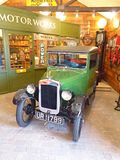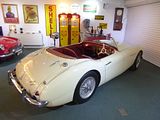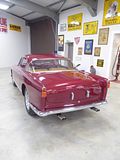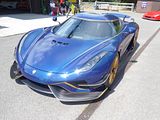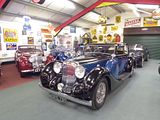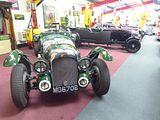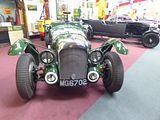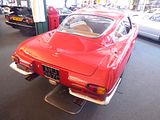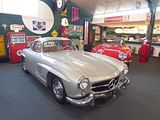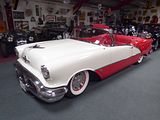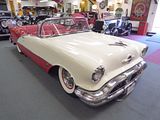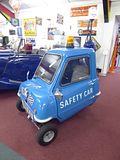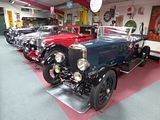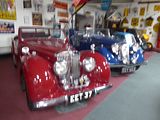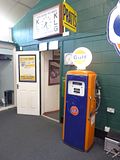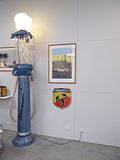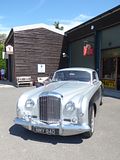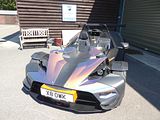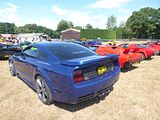When I saw a post by my friend Ciro Ciampi about a private visit he has arranged through his Petrolheadonism activities, I was sufficiently to intrigued to do some research. I’d not heard of Zach’s Garage, but the website suggested that this was a private collection of cars that were definitely worth seeing, and learning that there would be a special guest, and the opportunity for a limited number of like-minded enthusiasts, many of whom would doubtless have interesting cars, coupled with a promising looking weather forecast, I was sold on the idea, and duly booked up even though I did not know exactly where it was that I would be headed. We were told that the precise address would be sent to use the evening before, but that it was “somewhere in Surrey, not far from Guildford”. Sure enough, that is indeed where it is. The location is off a narrow country lane in very leafy countryside and when you get there you head down a long driveway and eventually get to a number of large buildings which are a sort of mix between farm buildings and an aircraft hangar. They are grouped together in two pairs, all told being six separate buildings. Parking was on the grass beyond the buildings where there was a large stall set up cooking some particularly tasty German sausages. Here is what I saw:
ZACH’S GARAGE CARS and DISPLAYS
Although this is known as Zach’s Garage, the collection actually belongs to Zach’s parents, Robert and Tanya Lewis. Robert and Tanya started collecting beautiful cars and memorabilia in 2005 taking over from their passion for sailing. They now have over 70 beautiful cars on display ranging from 1903 to the present day. They are immaculate as Robert believes in restoring everything back to concours condition. He employs four full time staff and has a fully equipped workshop, machine shop and paint shops where everything is restored in-house. Robert was on hand to welcome us all, and to talk about the cars giving us a very personal sort of guided tour. He clearly is not short of money, but he just talked in a very matter of fact way about how he acquires and sells cars and the other artefacts he has in the collection, which have all been sourced from around the world. Although the cars all look pristine, he reassured us that as many of them as possible do get used including taking to the track at events such as Goodwood and le Mans Classic with Robert himself sometimes behind the wheel. Robert’s son, Zach, is the social media brains behind the collection and produces online content on all the usual sorts of channels, and he also helps with the business aspects which includes making most of the cars available to rent out to film companies and for weddings and other special events.
1933 Alvis SA Speed 20: The Alvis Speed 20 is a British touring car that was made between late 1931 and 1936 by Alvis Car and Engineering Company in Coventry. It went through four variants coded SA to SD. Our car features special coach workings by the company Vanden Plas, Vanden Plas produced bodies for specialist and up-market automobile manufacturers. Later the name became synonymous for luxury model designation cars from various subsidiaries of British Leyland and the Rover Group, last used in 2009 to denote the top-luxury version of the Jaguar XJ8. The car features unique features such as a lowered floor in the rear seats to hold a wedding dress, and a half roof design. The reason for the half roof design was implemented in the 30’s as it was seen as incorrect for the driver of the car to be under the same roof as the bride and groom. The engine for the Speed 20 was a heavily modified version of the one used in the preceding Silver Eagle cars, producing 87 bhp.
2018 Aston Martin Vanquish Zagato: In 2017 Aston Martin announced a limited series production of the Aston Martin Vanquish Zagato; the latest creation from its long-standing partnership with the prestigious Italian design-house Zagato. The Vanquish Zagato Concept was unveiled to great acclaim at the prestigious Concorso d’Eleganza Villa d’Este at Lake Como, Italy in May 2016. The Vanquish Zagato is available in 4 body styles – coupé, convertible, speedster, or shooting brake. 99 each were built of the coupé, convertible, and shooting brake, while a mere 28 speedsters were made, for a total of 325 cars. The Vanquish Zagato features the same AM29 V12 from the Vanquish S, which has a power output of 603 PS and 630 Nm (465 lb/ft) of torque, allowing the Vanquish Zagato to accelerate from 0 to 100 km/h (62 mph) in 3.5 seconds before reaching a top speed of 324 km/h (201 mph).
1931 Austin Seven Saloon: In 1920 Sir Herbert Austin commenced working on the concept of a smaller car, mainly to meet the needs of young families aspiring to own an affordable motor car. This idea was spurred on by the introduction of the Horsepower Tax in 1921. His design concept marked a departure from his company’s conservative motoring past and Austin received considerable opposition from his board of directors and creditors. Austin Decided to use a small four-cylinder 696cc engine giving a RAC rating of a huge 7.2 BHP. The car’s upper body is also coated in leather, as this was introduced in 1931.
Austin Seven Swallow: Seven’s were popular with coach building companies who would purchase the chassis form Austin and build there own bodies, companies such as Avon of Warwick, Gordon England or in this case the Swallow Coachbuilding Company of Blackpool. Swallow run by (Sir) William Lyons later evolved to become Jaguar but at this time were supplementing there original business of building motorcycle sidecars, having originally bodied caravans. The key to the Swallow was an order by London dealers Henley for 100 examples in 1927. The Swallow was produced in Saloon, Coupe and Sports to a total of around 3500 cars, selling at £187 new.
1960 Austin Healey 3000: Built from 1959 to 1967 the 3000 is the best known of the “big Healey” models. The car’s bodywork was made by Jensen Motors and the vehicles were assembled at BMC’s MG Works in Abingdon, alongside the corporation’s MG models. During its production life, the car transitioned from an open sports car, albeit with a child-transporting 2+2 option, to a sports convertible. The 3-litre 3000 was a highly successful car, which won its class in many European rallies in its heyday and is still raced in classic car competitions by enthusiasts today.
1938 BMW 327: Among some enthusiasts, the 327 has subsequently been overshadowed by its more uncompromising sibling, the 80 bhp (60 kW) BMW 328 which appeared in April 1936. In its day, however, the 327 was the bigger seller, with 1,396 base engined versions built between 1937 and 1941. During the 1930s, Eisenach was the centre of BMW’s automobile manufacturing. In 1945, Eisenach was occupied by United States forces. However, the wartime allies had already agreed that Thuringia would fall within the Soviet occupation zone. BMW’s automobile factory in Eisenach was not fully destroyed, and assembly of the 327 resumed. Clear production figures are hard to obtain, but many of the 327s surviving with collectors into the twenty-first century were post-war products. Another interesting fact is that the 327 was the first car fitted with a steering locking device to prevent the vehicle being stolen.
Brabham BMW
2017 Caterham 620R
Chevron
1960 Daimler SP250 “Dart”: Daimler launched their new sports car at the New York Motorshow of 1959. They wanted to crack the American market and the styling had transatlantic overtones to suit. The car was originally called the Dart, but Daimler quickly succumbed to the threat of legal action from Chrysler’s Dodge division and rechristened it the SP250. The newcomer was clothed in a tough fibreglass body and built around a traditional cruciform-braced ladder-frame chassis, the initial version of which (as found on A specification cars), was sadly lacking in torsional rigidity. By 1960, the Daimler Motor Company was in Jaguar’s hands and the so-called B specification SP250s featured a much stiffer frame, equipped with additional outriggers and a strengthening hoop between the B posts. The jewel in the car’s crown was its engine, a silky smooth 2.5-litre V-8 unit designed by Edward Turner. With 140bhp on tap and a low all-up weight, the Daimler’s performance was strong and the sound was one to savour. Suspension was independent with wishbones and coil springs at the front and a live axle hung on leaf springs at the rear. Braking was by hydraulically-operated discs all-round.
Ferrari 250 GT Europa: Dating from 1954 is this 250 GT Europa, a grand touring car produced by Ferrari in 1954 and 1955. It was the first real GT car manufactured by Ferrari and the first in a long lineage of Ferrari road-cars with Gran Turismo moniker in their name. They were also the first to have GT suffix in the chassis number instead of EU. The 250 Europa GT was seen as a road-going version of the 250 MM race car, and also as a second series to the 250 Europa. Up to this point, Ferrari offered semi-race car models that could be driven on the roads. Those were the past Inter-series offered from Maranello, but were not as practical for the elite clientele to be able to use every day. The start of the true road-car trend for Ferrari was the 250 Europa, which was soon followed by Europa GT, sporting ubiquitous Colombo 250-series 3.0-litre V12 engine. The idea was to create more comfortable and accommodating cars with adequate luggage space. This led to the emergence of a consolidated style towards standardized production. The introduction of the 250 GT series was a major turning point in the rise of Ferrari as a serial manufacturer. Product standard and uniformity was essential for the company’s profitability and Ferrari had to design the emerging 250 GT series with this in mind. Ferrari grew their road-going production, expanded their factory and light-alloy foundry. With it and a reliable power unit, Ferrari could meet the needs of more customers, with an unchanging goal to finance the racing activities. Ferrari chose Pinin Farina as their coachbuilder to realise the bodywork. This cooperation, that begun with a historic meeting of Enzo Ferrari and Battista Farina in a restaurant in 1951, will remain fruitful for many decades for Ferrari production cars. The exterior design was mostly carried over from the Europa, from which it was developed. Pinin Farina offered two body variants of the Europa GT. The three-window, two-door coupé with panoramic rear window and the other with additional rear side windows. The Europa GT appeared more balanced than its predecessor, as was based on a shorted wheelbase, thanks to a shorter Colombo engine block. Inside of the car remained unchanged in terms of dimensions and space. Externally only the distance from the front wheel arch to the A-post was reduced. The front of the car remained unchanged with a dominant egg-crate grille that became a strong identifying feature. Sides were almost devoid of any additional decoration. Most of the Europa GT cars had Pinin Farina designed and built bodywork and those had a similar, near identical established style. In total only 35 Europa GTs were manufactured.
1972 Ferrari 365 GTC/4: Made shortly after the Famous Daytona, the GTC/4 was more affordable but just as exhilarating to drive as its older brother. The Ferrari 365 GTC/4 (Type F101) is a 2+2 grand tourer produced by Ferrari from 1971 to 1972. It was based on the chassis of the Ferrari 365 GTB/4 “Daytona”. In the very short two-year production run 505 examples of the GTC/4 were produced. Its chassis and drivetrain, however, were carried over mostly unaltered (apart from a wheelbase stretch to provide more satisfying rear seat room) on its successor, the 1972 365 GT4 2+2. The 365 GTC/4 shared the chassis and engine block as the 365 GTB/4 Daytona, riding on the same wheelbase and suspension. Many changes were made to make it a more comfortable grand tourer than its two-seat predecessor and sibling. These included softer spring rate and hydraulic power steering. The 365 produces 335 BHP and for 1972 that is a lot of power! With an estimated top speed of 163 mph. The car sits in an incredible condition, and features what can only be seen as a truly concourse condition.
1988 Ferrari F40: The Ferrari F40 was released in 1987 and was the predecessor to the almighty 288 GTO to celebrate 40 years of Ferrari, and was their most extreme road car they had ever made. Today the F40 is one of the most desirable and on of the most iconic classic cars ever made. With only 1,311 cars made and a lot of them destroyed due to crashes, the car became somewhat of a unicorn. The F40 is powered by a 2.9L Twin Turbocharged V8, producing 478 bhp, the car became infamous for its ferocious turbo boost making the car accelerate violently and hence why people often crashed them. The F40 was replaced by the also iconic Ferrari F50.
Ferrari Enzo: Widely rumoured to be going to be called the F60, Ferrari surprised everyone at its 2002 unveiling by giving their latest hypercar the name Enzo. This car was built using even more Formula One technology, such as a carbon-fibre body, F1-style electrohydraulic shift transmission, and carbon fibre-reinforced silicon carbide (C/SiC) ceramic composite disc brakes. Also used were technologies not allowed in F1 such as active aerodynamics and traction control. After a downforce of 7600 N (1700 lb/ft) is reached at 300 km/h (186 mph) the rear wing is actuated by computer to maintain that downforce. The Enzo’s F140 B V12 engine was the first of a new generation for Ferrari. It was based on the design of the V8 found in Maserati’s Quattroporte, using the same basic design and 104 mm (4.1 in) bore spacing. The Enzo formed the basis for a whole array of other very special cars, including the FXX and FXX Evoluzione cars and the Maserati MC12 and MC12 Evoluzione as well as the Ferrari P4/5 and the Millechilli. Originally, 349 of these were going to be produced, but Ferrari decided to add another 50 to the total, meaning 400 in total were produced up until 2004.
2020 Ferrari 488 Pista: The Ferrari 488 Pista is one of Ferrari’s special edition cars, as the word Pista translates from Italian, “track” the 488 Pista is the light weight, track focused parent of the standard 488. weighing 90kg less than the standard 488 and a lot less made. In order to receive this car you had to fit a strict criteria, making this car much more exclusive that a standard Ferrari, and certainly making it more desirable. We have two Ferrari Pista’s available, this one seen here finished in Rossa Corsa with silver and blue stripe. There are two others in the collection, a second one also featuring Rossa Corsa paint, but finished in an FXXK race-car livery.
Ford Model T
1964 Ford Lotus Cortina: Throughout the 1960s Ford pursued an ambitious and wide-ranging motor sports programme – ‘Total Performance’ – that would see the ‘Blue Oval’ triumph at Le Mans with the GT40, while Ford-powered cars also won at Indianapolis and took the Formula 1 World Championship. In Group 2 production car racing the firm was just as dominant, thanks to one particular model: the Ford Lotus Cortina. Production of the Lotus Cortina began in February 1963, but it was not until September of that year that it was eligible to race. Driven by Jack Sears, a works Lotus Cortina finished 1st in class on the model’s racing debut at Oulton Park on 20th September, with Trevor Taylor second. The following year the late Jim Clark, a supremely gifted driver who seemingly could do anything with any car, took the British Touring Car Championship driving a works-entered example. Clark’s spirited driving of the Lotus Cortina, often cornering with only three wheels on the ground, will never be forgotten by those privileged enough to have witnessed it.
1950 Frazer Nash Le Mans Replica: The car was famous in the 50’s for its renowned handling qualities and performance capabilities. The post-war Frazer Nash’s made use of the Bristol six-cylinder engine which was similar to the BMW 328. In fact, one of the very first post-war Frazer Nash models was little more than a re-bodied BMW 328. Around this time, H.J. Adlington persuaded 328 designer Fritz Fiedler to come to England and assist with production of the Bristol engine. The car has recently been race prepared by our in house mechanics, and will be competitively raced in 2019 and onwards.
1936 Jaguar SS1 Tourer: This is the 1936 Jaguar SS1 Tourer, restored professionally by davenport cars in Bedfordshire. The car is in incredible condition and has been featured and won in multiple concourse events such as Salon Prìve where it won best in show. This car is the most sought after model in the S.S range, featuring a 2 1/2 Litre straight 6 engine and a 4 speed manual gearbox. Under the guidance of the chairman, William Lyons, the company survived the depression years of the 1930s by making a series of beautifully styled cars offering exceptional value for money although some enthusiasts criticised them at the time for being “more show than go”. The engines and chassis supplied by the Standard Motor Company were fitted with Swallow bodies styled under Lyons supervision. The first of the SS range of cars available to the public was the 1932 SS 1 with a 2-litre or 2½-litre side-valve, six-cylinder engine.
1934 Jaguar SS1 Airline: This is a 1934 Jaguar SS1 Airline. which has received a professional restoration and is now in a concourse condition. This car features the 2.6 Litre engine, very similar to the one seen in the S.S 1 Tourer. Under the guidance of the chairman, William Lyons, the company survived the depression years of the 1930s by making a series of beautifully styled cars offering exceptional value for money although some enthusiasts criticised them at the time for being “more show than go”. The engines and chassis supplied by the Standard Motor Company were fitted with Swallow bodies styled under Lyons supervision. The first of the SS range of cars available to the public was the 1932 SS 1 with 2-litre or 2½-litre side-valve, six-cylinder engine. The difference between the Airline and the Tourer is the coach working, the Airline has been finished in the “airline style” which features the sloping back and wider running boards.
1937 Jaguar SS100: This superb and fully restored 2½-Litre Jaguar SS100, chassis number ‘18054’ is listed in the SS 100 Registry and known to the Classic Jaguar Association. Its history file is truly extensive and includes period pictures (as seen here), correspondence between various owners, renovation photographs, original buff logbook, numerous bills, expired MoTs, etc. The Jaguar legend, ‘DUV 71’ possesses one of the most comprehensive history files imaginable as well as undisputed provenance. The SS100 was known to be the first production car to do 100mph!!
1952 Jaguar C Type: The XK120C’s astonishing debut victory in the 1951 Le Mans 24-Hour Race and its follow-up win in ’53 established Jaguar’s first purpose-built racing sports car as one of the all-time great competition automobiles. Jaguar built only 54 C-Types and it is worth noting that the first three Formula 1 World Champions – Guiseppe Farina, Alberto Ascari and Juan-Manuel Fangio – all bought them as road cars. It is not hard to understand why: at the time of its introduction the C-Type represented the state of the art in racing car engineering and thus was one of the most advanced road vehicles in the world. Those multiple Le Mans wins in the 1950s, as well as numerous victories in the other great classic endurance events, coupled with superlative driving qualities that made it so attractive to three of the greatest drivers in history, there really is no doubt that the C-Type is one of the worlds greatest classic sports car.
1968 Jaguar E Type: The E-type was made between 1961 and 1975. It’s a combination of beauty, high performance, and competitive pricing that established the model as an icon of the motoring world. The E-Type was based on Jaguar’s D-Type racing car, featuring similar features such as the monocoque construction. when the E-Type was released in 1961, the mighty Enzo Ferrari called the E-Type “the most beautiful car ever made” so that must tell you something!
1964 Jaguar 3.8 Mark 2: The MK2 is one of the most readily recognised cars of the 1960s thanks in part to countless appearances in films and on television, Jaguar’s seminal Mk2 saloon set the standard for the class throughout its entire production life and today remains highly prized by enthusiasts. With the advent of the Mk2 in October 1959, the 3.8-litre version of Jaguar’s XK twin-cam six became available for the first time in the company’s medium-sized saloon, which in top-of-the-range, 3.8-litre, manual/overdrive configuration was a genuine 125mph car capable of reaching 60mph in 8.5 seconds.
2020 Koenigsegg Regera: This is ar Koenigsegg Regera, specifically designed to be a luxury mega car alternative to Koenigsegg’s traditional extreme, light weight, race-like road cars. The Koenigsegg Regera combines a powerful twin-turbo V8 combustion engine with three electric motors and cutting edge battery technology via new powertrain technology called Koenigsegg Direct Drive. This revolutionary technology removes the traditional gearbox, making the car lighter and more efficient. The Koenigsegg Regera continues Koenigsegg’s tradition of speed and performance, but with innovative technology that blends outrageous speed, supreme comfort, and a unique Direct Drive experience. The Regera is one of the most special cars in the collection, with its bespoke blue carbon fiber body with 24 karat gold leaf, and its massive 1500bhp twin-turbo v8, and its price tag in the millions of pounds, it is the largest statement that can be made, any time, any place.
1938 Lagonda V12 Saloon: his car was made for the 5th earl howe, who won LeMans in 1931 with Sir Henry Birkin. Earl Howe bought the car for multiple reasons, but the main ones actually being the sublime performance and handling. The car is a truly beautiful example of what Lagonda was capable of in the ’30s. Finished in black and blue, with a black leather interior, the car is a truly special place to be, whether its being driven in or driving yourself.
1939 Lagonda V12 Le Mans: This car has been raced at le Mans all of its life, and still races at the Le Mans Classic. The ultra-light bodywork of the V12 Le Mans was infinitely lighter than it may look to the eye and was constructed in five major sections, all of hand-beaten aluminium sheet mounted directly on to the chassis with no interior framework whatsoever, and retained by quick-release fasteners. Closely fitting around the engine, it represented overall a most streamlined shape. Now named by us “the speeding lobster” the car sounds as good as it looks with a straight through exhaust coming from its V12 heart. Robert explained to us that although the car looks OK, if you were to open the bonnet, there is nothing there at present. The engine had a major blowup at le Mans this year and he showed us the remains of one of the pistons. He has sourced a genuine Lagonda engine to install to replace the original, so the car will be back in action soon.
1945 Lagonda M45: This is one of the best-restored Lagonda’s in the collection. finished in green with matching green leather, this car is certainly a piece of art. The rear of the car is actually made from ash wood and covered in leather. the near 100 mph M45 was powered by a 4.5-litre Meadows-supplied 6-cylinder 4467 cc engine. An out and out sporting version of the M45R Rapide, with the tuned M45 engine and a shorter chassis to the M45R, this truly was an exceptional sports car for its day.
Lamborghini 2R: Ferruccio Lamborghini’s successful tractor empire preceded his supercar one by no less than 15 years, and it was reputedly only an argument with Enzo Ferrari over a faulty clutch in his Ferrari 250 GT that prompted Signore Lamborghini to embrace cars as well as farm vehicles. The tractor is powered by a 36bhp three-cylinder engine of 2193cc and comes complete with PTO and pick up hitch. The tractor starts on the “button” and you will be surprised to know its not as fast as an Aventador.
1963 Lamborghini 400GT 2+2: The 400 GT was and still is an incredibly rare vehicle. with only 247 cars believed to be built, and only 5 of which were RHD. The 400 GT was built between 1966-1968 and was the replacement to the 350 GT. The 400 GT featured a different roofline, and minor sheet metal changes to its predecessor. The car featured updated styling from Touring Superleggera and a Lamborghini designed gearbox, with Porsche style synchromesh on all gears. The car is an incredible event to drive simply due to how easy it is to drive!
1968 Lamborghini Miura P400S: Built-in the 70s, the Miura was built between 1966 and 1973, and the last edition of the Miura was called the P400 SVJ spider. The Miura production started in 1966 with the P400 and became one of the most iconic sports cars ever produced, and is often referred to as the first supercar. The Miura featured a 3.9L V12 producing around 365 BHP and was capable of 170 mph. The Miura was the first debut at the 1966 Geneva Motor Show and was the star car of the show. One of the most requested tasks on the Lamborghini stand during the show was for people to see the newly revised power plant, but due to Lamborghini finishing the Miura a few days before the motor-show, they did not have time to insert the new engine, so instead, they placed a large amount of ballast in the rear of the car to keep the rear of the car weighted
1989 Lamborghini Countach 25th Anniversary: Built in the late 80s, the 25th anniversary was the last edition of the Countach series. The car’s production started in 1974 with the LP400 and ended with the 25th anniversary. The production of the Countach ended in 1990 and was replaced by the Diablo. The Countach was a poster car for a lot of people. The car, featuring bold styling by the famous Italian designer Bertone was a bold move from Lamborghini, but resulting in one of the most iconic supercars in the world. The Countach shared the same 5.0 litre V12 as the previous Countach, the 5000 QV and boasted 448 BHP.
Lamborghini Aventador: The Aventador has been a huge success for Lamborghini. It was first seen at the 2011 Geneva Show, with the full name of Aventador LP700-4 Coupe, the numbers denoting the output of 700 bhp from the all-new V12 engine and the 4 meaning four wheel drive, something which has featured on every Aventador since. The launch price was £250,000 but even so within a month, Lamborghini had a year’s worth of orders, and within a year, 1000 had been built. In November 2012 a Roadster version arrived, which was very similar to the Coupe, but with a lift-out roof panel. A suite of mechanical changes came at this point, with a cylinder deactiviation technology helping to improve fuel consumption and cut emissions. To mark half a century of car production, in April 2013, the LP720-4 50th Anniversary was launched, with 100 units available. As well as the extra 20 bhp, these had a mildly redesigned nose and tail, special paintwork and unique interior trim. A Roadster version followed in December 2014, the LP 700-4 Pirelli Edition. This did not have the extra power, but did feature two tone paint, unique wheels and a transparent engine cover, with the engine bay finished in carbon fibre. Lamborghini turned up the wick in march 2015 with the LP750-4 SuperVeloce, or SV for short, which featured and extra 50 bhp and a 50 kg weight reduction largely thanks to the use of more carbon fibre. A Roadster version followed a few months later. At the start of 2017, the entry level model was upgraded, becoming the Aventador S, initially as a Coupe, but the Roadster followed later in the year. This had a power boost to 740 bhp, improved aerodynamics, and a revised suspension, as well as the introduction of four-wheel steering and a new TFT dash. In 2018 the 8000th model was produced and just a month after announcing this, the ultimate model appeared, the Aventador SVJ. This boasted 770 bhp and further aerodynamic aids. Production of this version was limited to 900 units. For those who wanted something even more exclusive there were 63 examples of the SVJ 63 edition to mark the formation of the company in 1963.
1936 Leyland Lynx: This Leyland Lynx was first allocated FYV661 in 1939, but wasn’t registered for the road until 1945; it is believed that it was requisitioned for military use during the war years. From the end of World War II the Lynx was used as a can carrier, transporting two-gallon cans of oil or petroleum fuels for Shell-Mex BP. Sold in 1952 to Kennings Tankers Ltd in Ossett near Wakefield, West Yorkshire, where it remained until 1957, the Lynx was then bought by a local farmer, Mr Raymond Harrison who licensed it under Farmers Goods regulations. The purchase was his response to the Suez Crisis of 1956, which threatened to drastically reduce fuel and animal foodstuff supplies that were delivered by outside hauliers, his thinking being to make himself independent and safeguard deliveries. As it turned out, it was rarely needed for this purpose, and instead hauled his farm crops until 1964, when it was parked up. The can carrier was purchased by the vendor in 1996 and a ground up restoration began which was finally completed in 2005. It was noted that this lorry complied with fire regulations for the transportation of petroleum products; the all-metal cab and the electrics were all earthed directly back to the battery rather than through the chassis.
1955 Mercedes-Benz 300SC: This was the first car to enter what became the collection. The 300SC was made by Mercedes in 1955 and was Mercedes’ answer to the Rolls Royce Silver Cloud. There were only 50 300SC Mercedes made during their production, and combined with their amazing styling, the innovative fuel injection system and luxurious interior, made this car one of the greatest Mercedes ever made, but unfortunately proved too expensive for production. Our 300SC was fully restored in 1990 in Germany, and was used as a showpiece by the restoration company.
Mercedes-Benz 300SL: Known under development as the W198, the first iteration of the SL-Class grand tourer was the fastest production car of its day. Introduced in 1954 as a two-seat coupé with distinctive gull-wing doors, it was later offered as an open roadster. Built by Daimler-Benz AG, the direct fuel injected production model was based on the company’s highly successful yet somewhat less powerful carburettor overhead cam straight 6 1952 racer, the W194. The idea of a toned-down Grand Prix car tailored to affluent performance enthusiasts in the booming post-war American market was suggested by Max Hoffman. Mercedes accepted the gamble and the new 300 SL – 300 for its 3.0 litre engine displacement and SL for Sport Leicht (Sport Light) – was introduced at the 1954 New York Auto Show rather than the Frankfurt or Geneva gatherings company models made their usual debuts. Immediately successful and today iconic, the 300 SL stood alone with its distinctive doors, first-ever production fuel injection, and world’s fastest top speed. Even with the upward opening doors, the 300 SL had an unusually high sill, making entry and exit from the car’s cockpit problematic. A steering wheel with a tilt-away column was added to improve driver access. The 300 SL’s main body was steel, with aluminium bonnet, doors and boot lid. It could also be ordered with an 80 kg (180 lb) saving all-aluminium outer skin at tremendous added cost; just 29 were made. Like the W194, the 300 SL borrowed its 3.0 litre overhead cam straight-6 from the regular four-door 300 (W186 “Adenauer”) luxury tourer introduced in 1951. Featuring an innovative diagonal aluminium head that allowed for larger intake and exhaust valves, it was canted to the right at forty-five-degrees to fit under the SL’s considerably lower bonnet line. In place of the W194’s triple two-barrel Solex carburettors, a groundbreaking Bosch mechanical direct fuel injection was installed, boosting power almost 25% over the Grand Prix car’s. Derived from the DB 601 V12 used on the Messerschmitt Bf 109E fighter of World War II, it raised output from 175 hp to 215 hp, almost double that of the original Type 300 sedan’s 115 hp. An optional, even more powerful version, with radical camshaft developed 240 hp @ 6100 rpm and a maximum torque of 217 lb⋅ft @ 4800 rpm, but was rough for city use. The result was a top speed of up to 260 km/h (160 mph) depending on gear ratio and drag, making the 300 SL the fastest production car of its time. However, unlike today’s electrically powered fuel injection systems, the 300 SL’s mechanical fuel pump would continue to inject gasoline into the engine during the interval between shutting off the ignition and the engine’s coming to a stop; this unburned gasoline washed lubricating oil from the cylinder walls, which not only left them unprotected in affected areas during start-up but would dilute the engine’s entire oil supply if the car was not driven hard or long enough to reach a sufficient temperature to evaporate the fuel out of the oil. Exacerbating the problem was the engine’s large racing-oriented oil cooler and enormous 10 litre oil capacity, which virtually guaranteed the oil would not get hot enough. In practice, many owners would block off airflow through the oil cooler and stick rigidly to the appropriately low 1,000 mile recommended oil change interval. An auxiliary fuel pump provided additional fuel for extended high speed operation or cold starts; overuse would also lead to dilution of the oil., Clutch operation was initially very heavy, remedied by an improved clutch arm helper spring which reduced pedal force. From March 1963 to the end of production later that year, a light alloy crankcase was used on a total of 209 vehicles. Aerodynamics played an important role in the car’s speed, with Mercedes-Benz engineers placing horizontal “eyebrows” over the wheel openings to reduce drag. Unlike many cars of the 1950s, steering was relatively precise and the four-wheel independent suspension allowed for a reasonably comfortable ride and markedly better overall handling. However, the rear swing axle, jointed only at the differential, not at the wheels themselves, could be treacherous at high speeds or on imperfect roads due to extreme changes in camber. The enormous fuel tank capacity also caused a considerable difference in handling depending on the quantity of fuel on board. More than 80% of the vehicle’s total production of approximately 1400 units were sold in the US, making the Gullwing the first Mercedes-Benz widely successful outside its home market and thoroughly validating Hoffman’s prediction. The 300 SL is credited with changing the company’s image in America from a manufacturer of solid but staid luxury automobiles to one capable of rendering high-performance sports cars. It should be noted initial sales were sluggish due to many things, of which the price was one. Initial prices were about $6,400, a new Chevrolet Bel-Air could be purchased for $1,700 in the same year. Then there were few mechanics, even at the dealers, who understood the fuel injection system enough to do repairs. Nonetheless, 1400 were built by 1957, at which point Mercedes introduced a roadster version which was broadly similar, but with conventional doors. It was produced until 1963, and achieved sales of 1858 units.
Mercedes-Benz SLS: The SLS was the first Mercedes-Benz designed and built from scratch entirely by AMG. Upon its introduction at the 2009 Frankfurt Motor Show, the SLS AMG’s 571 PS (563 bhp) M159 engine was according to AMG “the world’s most powerful naturally aspirated production series engine” ever produced. The SLS AMG was designed by Mark Fetherston to be a modern 300SL Gullwing, adopting the feature of the gull-wing doors that swing open upwards on gas struts, and must be closed manually as AMG engineers decided against the 41 kg (90 lb) of additional weight that auto-closing systems would have added to the car. In case of a roll-over, the doors can be fully detached to allow the occupants to leave the vehicle. The SLS AMG Roadster was unveiled at the 2011 Frankfurt International Motor Show, as convertible variant, with conventional doors and three-layered fabric soft top (having a magnesium, steel and aluminium construction) which opens and closes in 11 seconds, and can be operated on the move at up to 50 km/h (31 mph). The roadster’s DIN kerb weight is 40 kg (88 lb) more than the SLS AMG Coupé. Certain reinforcements were made to the roadster in order to compensate for the loss of roof which includes side skirts with greater wall thicknesses and more chambers, a dashboard cross-member is supported against the windscreen frame and centre tunnel by additional struts, a curved strut between the soft top and the tank reinforces the rear axle, a reinforcing cross-member behind the seats to support the fixed roll-over protection system. An electric version of the car, the SLS AMG Electric Drive, was presented at the 2012 Paris Motor Show, but never entered production. The more focused Black Series, with more power and reduced weight did, though, following a presentation at the 2012 Los Angeles Show. Plenty of special editions of the car did, though, culminating in the 2014 SLS AMG GT Final Edition. The SLS was replaced by the somewhat cheaper (to build and hence to buy) AMG GT which remains in production.
MG PB: The PA and later PB replaced the J Type Midget. These 2-door sports cars used an updated version of the overhead camshaft, crossflow engine that was also used in the 1928 Morris Minor and Wolseley 10 as well as the J-type Midget of 1932 to 1934. It drove the rear wheels through a four-speed non-synchromesh gearbox. The chassis was a strengthened and slightly longer version of that used in the J-type with suspension by half-elliptic springs all round with rigid front and rear axles. Steering was initially by a Marles Weller and later a Bishop Cam system. The two-seat car had a wheelbase of 87″ and a track of 42″. Most cars were open two seaters, but streamlined Airline coupé bodies were also made. The P-type was also available as a four-seater, a car that suffered from a lack of power and poor rear ground clearance. Whereas J, K and L-type MGs differentiated between versions with the use of numbers, with 1 indicating a four-seater (the J1) and 2 a two-seater (the J2), this was not the case with the P-type (or its six-cylinder sister, the N-type Magnette), and there is no clue to the type in the name. The first version, the PA used an 847 cc engine similar to the one on the J-Type, but now with a 3-bearing crankshaft, larger camshaft and twin SU carburettors. It produced 36 bhp at 5,500 rpm. In 1935, a PA open two-seater cost £222. Around 2,000 PAs were made. In late 1936 the PA was replaced by the PB, which had a larger 939cc 43bhp engine and which is distinguished by a grille of vertical slats as opposed to the honeycomb pattern of the PA. 526 examples of the PB were made.
1934 MG K3: This car is still raced competitively today. The K3 is a car not to be overlooked, the heart of the car is a supercharged straight 6, and is incredibly fast even to nowadays standards. From 1933 to 1934, MG built 33 supercharged six-cylinder racing cars, which would turn out to be the most successful British competition model until the rise of Jaguar. The K3 Magnette generated 124 BHP at 6,500 rpm from a single overhead camshaft supercharged six-cylinder engine, with only 1,086 CC. This example was raced at the Mille Miglia by the famous race driver, Victor Gauntlet. The car also features a pre-select gearbox, which did exactly as it says on the tin, upon going into a corner, the driver can place the gear selector into the desired gear, and when the actual gear was wanted, the driver would just have to engage the clutch and the gear would then be engaged.
1932 MG race team support van: Based on the M-Type, this was a one off car built for the mg race teams mechanic. The only problem with that, is that the mechanic was 4 ft 6, and the car was made to measure. The MG M Type Midget was undoubtedly the first of a long line of MGs that were to make the sports car so popular throughout the world and it is almost impossible to overestimate the importance of the little car. The race van was built in 1932 at the end of the M type production, and there is believed to only be 1 race team support van. as the van was in the later years of the M-Type production, it had the larger engine output, with an outstanding 27 bhp.
1933 MG K2: There were a mere 20 of the road-going K2s built, numbered from K2001 through K2020. While the K2 was built in fewer numbers than the K3 (33 built), most K2s have been converted to look like their competition counterparts, with cycle fenders and torpedo-style coachwork. This competition pedigree means that very few have survived intact, and those scant few examples that do remain are counted among the most highly coveted and valuable of all pre-war MG sports cars. The car features the same 1.1L straight 6 as the K3, but it was only the later k2’s that had a supercharger fitted.
1949 MG TD: The MG TD can rightfully be described as the most popular of all the T series Midgets, following closely in the tracks of the TC Midget which was the car that put MG on a firm footing in the United States. The fact that the TC had become an overnight success in the American market helped secure a bright future for MG both at home and abroad. It is worth noting that during 1948 and 1949 which was when the TC was at its peak of popularity, many changes were taking place in the Nuffield group and by the summer of 1949 the production of the TC was outnumbered by the manufacture of non-sports car models such as the Riley one and a quarter litre and the two and a half litre with the production lines running parallel to those of the Y type saloons and unsuccessful YT tourer. Because of the cool reception for the YT tourer it became clear in 1949 that overseas customers for MG sports cars particularly the Americans wanted something a bit more modern and sophisticated than the TC, thus the TD!
1960 MG MGA: The MG A made its debut at the Frankfurt Motor Show in September 1955 and was well received by the press and sports car enthusiasts. The buying public endorsed the car to the extent that sales over its 7 year production period exceeded 101,000 units, making it the most popular sports car ever produced up until that time. In the first full year of production alone the MGA production exceeded 13,000 cars which outstripped the entire 4 year production of the very popular TC Midget. Initially the MGA was fitted with the “B” series power unit of 1,489 cc, however the engine capacity was increased from 1,489 cc to 1,600 cc giving an extra 6 bhp. The marginal 99 cc increase gave a 10% rise in power and a meaningful 17% increase in torque. our car has received a world class concourse restoration, and has been regarded as one of the best MG A’s in the world.
1964 MG MGB Roadster: This is our 1964 MG B. our MG B received a world class concourse restoration later in its life, and as it sits now its often regarded as of of the best examples of a MG B roadster in the world. The last MGB convertible rolled off the production line at the Abingdon factory on the 22nd of October 1980 and it ended an era of sports car motoring, not only of the MGB but also of MG sports cars in general. The first MGB to come off the line at Abingdon bearing chassis number G-HN3 101 left the factory in June 1962. The MGB, although launched in 1962, continued in production in similar form, right the way through to the end of its production. During this span of 18 years continuous production, the basic body shape remained the same, apart from the later models sporting impact resistant black bumpers front and rear from 1975 onwards.
1964 Mini Cooper S: The Mini is a small economy car produced by the English-based British Motor Corporation (BMC) and its successors from 1959 until 2000. The original is considered an icon of 1960s British popular culture. Its space-saving transverse engine, front-wheel drive layout allows 80% of the area of the car’s floor pan to be used for passengers and luggage. The Mini influenced a generation of car makers, and In 1999, the Mini was voted the second-most influential car of the 20th century, behind the Ford Model T, and ahead of the Citroën DS and Volkswagen Beetle. The example we own features the 1,275cc engine, and when we went to visit the person who sold the car to us, we found that the car needed restoring, but the chassis number is 003 thats the 3rd 1,275cc Cooper S ever made!
1933 Morgan JAP. The car was first registered on 7th March 1933 and dispatched two days later to the Morgan dealer, Granfield Lawrence. It still carries its original registration number ‘AGH 44’ and retains its original 60-degree JAP v-twin engine. As an early version of the Super Sports three-speeder, the car carries the desirable ‘beetle back’ coachwork and nickel-silver radiator with honeycomb core, while other attractive features include a twin float chamber AMAL carburettor,And yes, that is the engine on the outside of the car!
1934 Morris 10/4: The Morris Ten announced 1 September 1932 is a medium-sized car introduced for 1933 as the company’s offering in the important 10 hp sector of the British market. It continued through a series of variants until October 1948 when along with Morris’s Twelve and Fourteen it was replaced by the 13.5 hp Morris Oxford MO. In 1934, the Morris Ten was a new class of car for Morris now equipped with wire wheels and a new type of mud guarding domed wings with wing side shields. It was powered by a Morris 1292 cc four-cylinder side-valve engine that featured a single SU carburetor which produced 24 bhp at 3,200 rpm. The gearbox was a four-speed manual transmission unit, and Lockheed hydraulic brakes were fitted.
1957 Oldsmobile Rocket 88: In 1957, the basic Rocket 88 was officially named Golden Rocket 88, taken from Oldsmobile’s 1956 Motorama two-passenger show car. However, the only badging was an “88” underneath each taillight. Also for 1957 the “J2” option was offered, with three 2-barrel (0.32 m3) carburettors, similar to the Pontiac Tri-Power. The Super 88 continued as the upscale mid-line series. Under the hood, the Rocket V8 increased in displacement to 371 cubic inches and 277 horsepower (207 kW) for all models across the board. Although rare, three speed manual transmissions were still available. Styling highlights were more evolutionary than radical overall with three-piece rear window styling utilized on some models. Oldsmobile revived station wagons for the first time since 1950 with the Super 88 Fiesta being a four-door hardtop design.
Peel P50: In 1962 a company called Peel engineering was founded. Their aim was to make small (very small) vehicles for people to be able to drive in cities, for this was better for the environment. It was advertised as a 1 person 1 bag car. Powered by a time bending 49CC engine and a top speed of a quite literal death defying 39 MPH the P50 wasn’t exactly a spaceship. The P50 came in white, red and dark blue and came plentiful equipped with 1 windscreen wiper, no reverse gear but a handle at the back and a weight of 59KG. This car is the definition of exotic and feng shui.
Peel Trident: The Peel Trident was built from 1965 to 1966, approximately 45 were made and I can honestly say I’m not sure if this was good or not for peel ? The Trident replaced the P50 as a 2 seater micro car, and to peel, they probably saw this as a family wagon. Believe it or not, the trident got 100 miles to the gallon, this was because you could probable fill it up with a pint glass, but the trident was originally advertised as “cheaper than walking” the trident came in 2 forms the petrol engined, and the electric, the one we have is electric.
Porsche AP18: Ferdinand Porsche ran two branches of motor vehicle production in the 1950s starting with car for the people, the VW Beetle (and Porsche cars as well of course), but also a tractor for the farmers. And they were good at it. With four basic models and further horsepower derivations therein, they built an amazing 120,000 units between 1956 and 1963 initially linked with the Austrian company ‘Allgaier’ until, in 1957, they bought the company completely and opened a new dedicated factory. Indeed, in true Porsche style, they designed the first air-cooled, diesel engine.This tractor features a two-cylinder engine producing 18hp. Before we bought it, the vehicle had led a privileged life since it was used to manage land in Saint–Ferriol in the Roussillon, Southern France as a grape transporter for the family vineyard. It was then retired and spent the majority of its life in their medieval castle. Its second owner, a Belgian surgeon, then acquired the tractor in 2009 and restored it to its current condition.
Porsche 964 Turbo
1926 Renault NN Van: Founded by Louis Renault and his brothers Marcel and Fernand in 1898, the company that would become France’s biggest automobile manufacturer started humbly enough, with a solitary 1¾hp De Dion-engined prototype. By 1904 Renault was building its own engines – large-capacity fours at first, followed by the AX twin – and in 1908 introduced its first six-cylinder model despite Louis Renault’s aversion to such complication. Post-WWI, with motoring growing fast, Renault responded to the demand for smaller, cheaper cars by introducing the KJ, a 6CV rival to the newly introduced Citroën 5CV. Launched in 1923, the KJ was powered by a 951cc sidevalve four, notable for its detachable cylinder head, which drove via a cone clutch, three-speed gearbox and transverse-leaf rear axle. The KJ-type engine was retained for the longer-wheelbase Type NN of 1925. Unlike the KJ, which, unusually, was only available with a Renault-built body, the NN was offered with a choice of Billancourt-made coachwork or could be ordered in bare chassis form for bodying by independent coachbuilders. By the end of the 1920s Renault had become a massive operation, as prominent in the field of commercial vehicle manufacture as that of cars, and this left-hand drive light van is based on the Type NN chassis. The vehicle was restored by Beaufort Restoration Services (UK) Ltd in 1989 at a cost of £38,000. Finished in the livery of Holleshill Ltd, it is in excellent order throughout.
Renault Twizy F1
Rolls Royce Ghost
Sinclair C5: The Sinclair C5 is a one-person battery electric recumbent tricycle. It was the culmination of Sir Clive Sinclair’s long-running interest in electric vehicles. Although widely described as an “electric car”, Sinclair characterised it as a “vehicle, not a car”. Sinclair had become one of the UK’s best-known millionaires, and earned a knighthood, on the back of the highly successful Sinclair Research range of home computers in the early 1980s. He hoped to repeat his success in the electric vehicle market, which he saw as ripe for a new approach. The C5 emerged from an earlier project to produce a small electric car called the C1. After a change in the law, prompted by lobbying from bicycle manufacturers, Sinclair developed the C5 as an electrically powered tricycle with a polypropylene body and a chassis designed by Lotus Cars. It was intended to be the first in a series of increasingly ambitious electric vehicles, but the development of the follow-up C10 and C15 models never progressed further than the drawing board. On 10 January 1985, the C5 was unveiled at a glitzy launch event, but it received a less than enthusiastic reception from the British media. Its sales prospects were blighted by poor reviews and safety concerns expressed by consumer and motoring organisations. The vehicle’s limitations – a short range, a maximum speed of only 15 miles per hour (24 km/h) and a lack of weatherproofing – made it impractical for most people’s needs. It was marketed as an alternative to cars and bicycles, but ended up appealing to neither group of owners, and it was not available in shops until several months after its launch. Within three months of the launch, production had been slashed by 90%. Sales never picked up despite Sinclair’s optimistic forecasts and production ceased entirely by August 1985. Out of 14,000 C5s made, only 5,000 were sold before its manufacturer, Sinclair Vehicles, went into receivership. The C5 has been described as “one of the great marketing bombs of postwar British industry” and a “notorious … example of failure”. Despite its commercial failure, the C5 went on to become a cult item for collectors. Thousands of unsold C5s were purchased by investors and sold for hugely inflated prices, as much as £6,000 compared to the original retail value of £399. Enthusiasts have established owners’ clubs and some have modified their vehicles substantially, adding bigger wheels, jet engines, and high-powered electric motors to propel their C5s at speeds of up to 150 miles per hour (240 km/h).
1926 Sunbeam Twin Cam: This is a 1926 Sunbeam twin-cam, first seen at the 1926 earls court motor show, this was the actual car featured on the Motor Show stand which certainly gives it quite a special history.
1938 Triumph Dolomite: The Dolomite range was powered by new all-alloy overhead-valve engines, the work of Donald Healey, which featured efficient cross-flow cylinder heads, while the new four-speed gearbox boasted synchromesh on the top three ratios. Three different engines were available: 1,496cc and 1,767cc fours and a 1,991cc six, the latter derived from the old Climax unit. The cruciform braced Dolomite chassis was basically similar in layout to that of the outgoing Gloria, being upswept at the front and under-slung at the rear, although slightly wider to permit the accommodation of roomier bodies. Sleek and well proportioned, the latter were the work of Walter Belgrove, one of Britain’s foremost automotive stylists, though his adoption of an American-inspired ‘waterfall’ grille was not to everyone’s taste. This rare Triumph Dolomite Roadster Coupé was first registered on 28th October 1938 and is one of only eight surviving six-cylinder models known worldwide. a rare coachbuilt model representing the pinnacle of Triumph’s pre-war production.
1947 Triumph Roadster: Despite Donald Healey’s best efforts to reinvent Triumph as the British equivalent of Alfa Romeo, the firm was essentially bankrupt by the time war broke out in 1939. Subsequently revitalised by Standard impresario Sir John Black, Triumph was able to launch two new models – the 1800 Saloon and 1800 Roadster – during 1946. Styled by Frank Callaby, the latter was a flamboyant mix of 1930s styling cues and boasted what was reputedly the last dickie seat to be incorporated into a production car. Bodied in aluminium alloy over ash.
1959 Triumph TR3a: The Triumph TR3 is a British sports car produced between 1955 and 1962 by the Standard-Triumph Motor Company based in Coventry. The TR3 is an evolution of the company’s earlier TR2 model, with greater power and improved braking. Updated variants, popularly but unofficially known as the “TR3A” and “TR3B”, entered production in 1957 and 1962 respectively. The TR3 was succeeded by the Michelotti-styled, mechanically similar Triumph TR4. The “TR3A” was a minor update from the TR3. The updates included the new wide front grill, exterior door handles, lockable boot handle and came with a full tool kit as standard (this was an option on the TR3). The total production run of the “TR3A” was 58,236. This makes it the third best-selling TR after the TR6 and TR7. The TR3A was so successful that the original panel moulds eventually wore out and had to be replaced. In 1959 a slightly modified version came out that had raised stampings under the bonnet and boot hinges and under the door handles, as well as a redesigned rear floor section.
Williams-Renault
As well as the cars, there are vast numbers of artefacts that line each of the buildings. Robert is as interested in old petrol pumps and vintage signage as the cars he has, and he talked about how rare some of these are and how he really does have to trawl the world to find them. Some of the prices are eye watering but there have been others where the owner did not realise just how rare the item was and he was able to secure them for a fraction of what they could now be sold for.
One of the special items that Robert highlighted to us all was this, a genuine Dalek that was used in the filming of Dr Who. Several were made but this is the only that can genuinely move of its own accord.
GUEST OF HONOUR
As an added bonus, there was a special guest of honour in attendance, none other than Valentino Balboni. He spend the time wandering, looking at the cars and talking to people and then was asked to take the mic and answer some questions that Ciro posed to him. He had a seemingly endless supply of anecdotes and stories from his distinguished career as Lamborghini’s chief test driver and was not afraid to tell us things as they really were. To be honest, we could probably all have listened to him all day, but alas he had to whisked away for his next engagement, so the session ended, with us all wanting to hear more.
VISITING CARS
Not surprisingly, the majority of the cars from those attending the event here were really rather special, too, and they made for quite an impressive site parked up on the grass beyond the collection buildings.
ABARTH
Just one Abarth here, the 124 Spider GT that belongs to Neil “Curly” Potter, who acquired off from Dave Quinn a couple of years ago. Eagerly awaited, the 124 Spider went on sale in September 2016. A quick reminder as to what this car is: The Abarth 124 Spider was developed in parallel with the Fiat model. It does cost a lot more, and there are those who think you don’t get enough extra for your money, but those who have driven it will tell you otherwise. You certainly get more power. The 1.4 MultiAir turbo unit jumps up from 138bhp to 168bhp, while torque also increases by a modest 10Nm to 250Nm, which gives it a 0-62mph time of 6.8 seconds, which is half a second quicker than the 2.0-litre Mazda MX-5. The top speed is 143mph. It weighs just 1060kg meaning a power-to-weight ratio of 158bhp-per-tonne, and with the new Record Monza exhaust system it sounds great even at idle. The Abarth version gets a stiffer suspension setup than the regular Fiat 124 Spider, with Bilstein dampers and beefed-up anti-roll bars. Bigger Brembo brakes also feature, with aluminium calipers. It can be had with a six-speed manual or six-speed automatic transmission with paddles, and the latter gets a Sport mode for quicker shifts. Many of the UK cars sport the ‘Heritage Look’ pack, which is a no-cost option. It brings a matt black bonnet and bootlid, plus red exterior trim detailing and has proved popular. The £29,565 starting price gets you standard equipment such as cruise control, climate control, Bluetooth, a DAB radio and satnav, plus Alcantara black and red (or pure black) seat trim. The automatic gearbox is a £2,035 extra, while an optional visibility pack brings LED DRLs, auto lights and wipers and rear parking sensors. Sales ended in 2019 by which time around 1800 had been delivered to the UK. Of these fewer than 100 are the GT model.
AC
There have been many different replica versions of the legendary AC Cobra. Both of these are the product of AK Sportscars, one dating from 2009 and the other from 2021. Based in Peterborough Cambridgeshire, AK was established in 1990 by two Cobra enthusiasts Ken Freeman (The glass fibre specialist) and Alan Frew (The fabrication specialist). AK took a low profile approach to the Cobra replica market but quickly gained a reputation for it’s sound engineering, excellent quality, keen pricing and high levels of customer service. As the company grew Ken was joined by his two son’s Jon and Daniel and daughter in-law Wendi and more recently his grand daughters Danni and Molly too. We are all passionate about the AK 427 and keen to keep it a small friendly business even as it has now grown into one of the biggest producers in the UK, a friendly welcome will always be had when you visit the factory. AK offer 3 chassis options to sit on the same body they produce. The “standard chassis” based on the Jaguar XJ6/ XJS. The” Generation II chassis” a lighter chassis based on the later Jaguar XJ40 which was designed by Ken and Jon in 2007 fearing the XJ6 and XJS Jaguar donor cars were becoming limited and lastly the” Generation III Supa lite chassis” which was born in 2015 following Jon’s love of track days in the AK 427. This chassis is lighter again than the Gen II and using a tubular element in the design has stiffened the chassis offering superb handling.
BENTLEY
A close relative of the Rolls Royce Silver Cloud, the S Type was first revealed in April 1955. It represented a complete redesign of the standard production car, the R Type. It was a more generously sized five- or six-seater saloon with the body manufactured in pressed steel with stressed skin construction, with the doors, bonnet and boot lid made of aluminium. The external appearance was very different, although the car still had the traditional radiator grille. Compared to the outgoing R Type, the new model had a three inch longer wheelbase, was lower of build without reducing headroom and with an enlarged luggage boot, softer suspension with electrically operated control of rear dampers, lighter steering and improved braking. The engine, still a clear descendants of the one originally used in the Rolls-Royce Twenty from 1922 to 1929, had its capacity increased to 4887cc, and a four-speed automatic gearbox was standard, with the ability to select individual ratios if desired, which was enough to give the Bentley a top speed of just over 100 mph and 0 – 60 acceleration times of around 13 seconds. Standard and from 1957, long wheelbase saloons were offered and some were sent to the coachbuilders for alternative bodies to be fitted. An upgrade in 1959, creating the S2, saw the installation of a new V8 engine, and in 1962, the S3 cars gained four round headlights. 3072 S Types were made, 145 of them with coachbuilt bodies as well as 35 of the long wheelbase cars, before the model was replaced by the new T Type in 1965. Seen here was an S2 Continental.
BMW
There were a number of BMW M models here including the E92 generation M3 as well as the follow on M4 and the current M5.
CONTERA
Designed and built in Britain by David Halford and Michail Papastergiou, this unique, versatile car, the MD1, is the first fully road legal model from Contera. Born from a love of the Group C vehicles we decided to design and build a mid-engine GT car with this styling and foot print in mind. Defining the exterior of the MD1 is the Group C inspired teardrop shaped roof with wrap-around windscreen that resides in a curvaceous and attention grabbing body shell. The MD1 has a wide stance and a dominating road presence and it’s really obvious that the Group C DNA was a major factor in the designing process. With external dimensions and footprint of a Group C car, sweeping lines paired with the dihedral (butterfly) style doors, and it’s see through engine cover gives the exotic/supercar identity to the car. This complete new car was designed from the start to be available to the international market as a three seater. The driver is positioned in the centre – the ultimate driving position. To us the obvious starting point was to design our own wrap around air flowed screen so distinctive to the Group C cars. In order for the driver to get the maximum vision and not lose the sports car senses, it was always going to be designed with the driver in the centre. With passengers seated either side and slightly behind the driver to create a spacious and comfortable interior. The central driving position is essential to get the best vision from the wrap around windscreen whose shape owes its style from the beautiful and purposeful Group C machinery. Able to accommodate tall drivers and the maximum visibility without the distraction of the A pillars. This also creates the essential and positive effect to be really user-friendly in left hand or right hand drive countries. The combination of teardrop shaped roof, wrap-around windscreen, central driving position, creates the ultimate package. Maximizes driver’s headroom for uncompromising driving experience for whoever is behind the wheel. The spacious driver’s foot-well, with the pedals placed exactly where they need to be, and without the intrusion of wheel wells, result in not only very comfortable cruising capable for long-distance driving, but also ideal for motorsport use. In order to make the MD1 a GT cruiser capable of long-distance trips in comfort, we fitted with a custom-made air con/heating system housed in a stylishly shaped ergonomic layout dashboard. Comes fully loaded with ABS, Speed Sensitive Power Steering, Tilt adjustable steering column, digital dash, CD/MP3 player, reversing camera, electric windows, electric mirrors, central locking (all come as standard). Powering the Contera MD1 is a 1JZ-GTE 2.5-litre twin turbocharged 6 inline Toyota/Yamaha engine that produces around 300bhp and 37.0 kgm (268 lb ft 363 Nm) @ 4800rpm of torque in standard factory trim, with the ability of 600-700bhp in upgraded version depending on the customer’s request. With the fuel tank well protected in the cabin area and with flat rear bulkhead creates the ideal engine bay. Really good access to work around the straight six engine, and at the same time easy to adapt a different power plant. In case of full custom build car (according the customer specs), use of V8 or V12 engine makes it possible, without any major modifications to the chassis. The proportions of a car are crucial as after all, it is these figures that determine the feel of a car – good handling and perfect weight distribution are key ingredients when designing a great sports car. The MD1 adheres to these principals with its low slung chassis, a mid-engine rear wheel drive design, 2695 mm wheelbase and 48-52 weight distribution. Even the fuel tank is designed so that as it drains, it always holds the centre of gravity. The MD1 is created to be a road legal sports car but was also designed with racing applications in mind. All this packaged in a smooth flowing shape styled from a design to match style and function from the various air vents around the car, every one functional. From the start great attention was placed on areas of air flow including the flat floor ending in functional air diffuser. All of this combines to give you a very smooth comfortable drive, with great power from the twin turbo 379 nm which red lines at 7100 rpm while still returning good fuel economy.
De TOMASO
Designed by American Tom Tjaarda, and unlike the Mangusta, which employed a steel backbone chassis, the Pantera was a steel monocoque design, the first instance of De Tomaso using this construction technique. The Pantera logo included a version of Argentina’s flag turned on its side with a T-shaped symbol that was the brand used by De Tomaso’s Argentinian cattle ranching ancestors. The car made its public debut in Modena in March 1970 and was presented at the 1970 New York Motor Show a few weeks later. Approximately a year later the first production Panteras were sold, and production was increased to three per day. The curious slat-backed seats which had attracted comment at the New York Show were replaced by more conventional body-hugging sports-car seats in the production cars: leg-room was generous but the pedals were off-set and headroom was insufficient for drivers above approximately 6 ft. Reflecting its makers’ transatlantic ambitions, the Pantera came with an abundance of standard features which appeared exotic in Europe, such as electric windows, air conditioning and even “doors that buzz when … open”. By the time the Pantera reached production, the interior was in most respects well sorted, although resting an arm on the central console could lead to inadvertently activating the poorly located cigarette lighter. The first 1971 Panteras were powered by a Ford 351 cu in (5.8 litre) V8 engine that produced a severely underrated 330 hp. Stock dynos over the years proved that power was more along the lines of about 380 hp. The high torque provided by the Ford engine reduced the need for excessive gear changing at low speeds: this made the car much less demanding to drive in urban conditions than many of the locally built competitor products. The ZF transaxle used in the Mangusta was also used for the Pantera: a passenger in an early Pantera recorded that the mechanical noises emanating from the transaxle were more intrusive than the well restrained engine noise. Power-assisted four-wheel disc brakes and rack and pinion steering were all standard equipment on the Pantera. The 1971 Pantera could accelerate to 60 mph in 5.5 seconds. In the summer of 1971, a visitor to the De Tomaso plant at Modena identified two different types of Pantera awaiting shipment, being respectively the European and American versions. From outside, the principal differences were the larger tail lamps on the cars destined for America, along with addition of corner marker lamps. The visitor was impressed by the large number of cars awaiting shipment; but in reality, spending the best part of a year under dust covers in a series of large hangars probably did nothing for the cash-flow of the business or the condition of some of the cars by the time they crossed the Atlantic. Late in 1971, Ford began importing Panteras for the American market to be sold through its Lincoln Mercury dealers. The first 75 cars were simply European imports and are known for their “push-button” door handles and hand-built Carrozzeria Vignale bodies. A total of 1,007 Panteras reached the United States that first year. These cars were poorly built, and several Panteras broke down during testing on Ford’s test track. Early crash testing at UCLA showed that safety cage engineering was not very well understood in the 1970s. Rust-proofing was minimal on these early cars, and the quality of fit and finish was poor, with large amounts of body solder being used to cover body panel flaws. Notably, Elvis Presley once fired a gun at his Pantera after it would not start. An L model (“Lusso”) was added in 1972 and a GTS version in 1974, but it was not enough and Ford ended their importation to the US in 1975, having sold around 5,500 cars. De Tomaso continued to build the car in ever-escalating forms of performance and luxury for almost two decades for sale in the rest of the world. A small number of Panteras were imported to the US by grey market importers in the 1980s, notably Panteramerica and AmeriSport. After 1974, Ford US discontinued the Cleveland 351 engine, but production continued in Australia until 1982. De Tomaso started sourcing their V8s from Australia once the American supplies dried up. These engines were tuned in Switzerland and were available with a range of outputs up to 360 PS. The chassis was completely revised in 1980, beginning with chassis number 9000. From May 1980 the lineup included the GT5, which had bonded and riveted-on fibreglass wheelarch extensions and from November 1984 the GT5S model which had blended arches and a distinctive wide-body look. The GT5 also incorporated better brakes, a more luxurious interior, much larger wheels and tires and the fibreglass body kit also included an air dam and side skirts. Production of the wide body GT5 (and similarly equipped narrow body GTS models) continued until 1985, when the GT5-S replaced the GT5. Although the factory has not made its records available, an analysis based on Vehicle Identification Numbers by the Pantera Owners Club of America (POCA) late model (9000 series) registrar has shown that fewer than 252 GT5 Panteras were likely to have been built. The GT5-S featured single piece flared steel fenders instead of the GT5’s riveted-on fibreglass flares, and a smaller steel front air dam. The ‘S’ in the GT5-S name stood for “steel”. Otherwise the GT5-S was largely identical to the GT5. The POCA 9000 series registrar’s VIN analysis indicates that fewer than 183 GT5-S Panteras were built. Concurrent GTS production continued, on a custom order and very limited basis, until the late 1980s. The car continued to use a Ford V8 engine, although in 1988, when the supply of Ford 351 Cleveland engines from Australia ran out, De Tomaso began installing Ford 351 Windsor engines in the Pantera instead. For 1990 the 351 was changed to the Ford 302 cu in (4942 cc, commonly called a “5.0”). Incorporating a Marcello Gandini facelift, suspension redesign, partial chassis redesign and the new, smaller engine, the Pantera 90 Si model was introduced in 1990. Only 38 90 Si models were sold before the Pantera was finally phased out in 1993 to make way for the radical, carbon-fibre-bodied Guarà. Some say 41 were built (with the last one not finished until 1996), of which four were targa models. The targas were converted by Pavesi directly off the production lines. In all, about 7,200 Panteras were built.
FERRARI
Introduced at the 1985 Frankfurt Show alongside the Mondial 3.2 series, the Ferrari 328 GTB and GTS (Type F106) were the successors to the Ferrari 308 GTB and GTS which had first been seen in October 1975. While mechanically still based on the 308 GTB and GTS respectively, small modifications were made to the body style and engine, most notably an increase in engine displacement to 3185 cc for increased power and torque output. As had been the case for a generation of the smaller Ferraris, the model name referred to the total cubic capacity of the engine, 3.2 litres, and 8 for the number of cylinders. Essentially the new model was a revised and updated version of the 308 GTS, which had survived for eight years without any radical change to the overall shape, albeit with various changes to the 3-litre engine. The 328 model presented a softening of the wedge profile of its predecessor, with a redesigned nose that had a more rounded shape, which was complemented by similar treatment to the tail valance panel. The revised nose and tail sections featured body colour bumpers integral with the valance panels, which reflected the work done concurrently to present the Mondial 3.2 models, with which they also shared a similar radiator grille and front light assembly layout. Thus all the eight-cylinder cars in the range shared fairly unified front and rear aspects, providing a homogeneous family image. The exhaust air louvres behind the retractable headlight pods on the 308 series disappeared, coupled with an increase in the size of the front lid radiator exhaust air louvre, which had been introduced on the 308 Quattrovalvole models, whilst a new style and position of exterior door catch was also provided. The interior trim also had a thorough overhaul, with new designs for the seat panel upholstery and stitching, revised door panels and pulls, together with more modern switchgear, which complemented the external updating details. Optional equipment available was air conditioning, metallic paint, Pirelli P7 tyres, a leather dashboard, leather headlining to the removable roof panel plus rear window surround, and a rear aerofoil (standard on Japanese market models). In the middle of 1988 ABS brakes were made available as an option, which necessitated a redesign of the suspension geometry to provide negative offset. This in turn meant that the road wheel design was changed to accommodate this feature. The original flat spoke “star” wheels became a convex design, in the style as fitted to the 3.2 Mondial models, whether ABS was fitted or not. The main European market 328 GTS models had a tubular chassis with a factory type reference F 106 MS 100. Disc brakes, with independent suspension via wishbones, coil springs, and hydraulic shock absorbers, were provided all round, with front and rear anti roll bars. There were various world market models, each having slight differences, with right and left hand drive available. The V8 engine was essentially of the same design as that used in the 308 Quattrovalvole model, with an increase in capacity to 3185 cc. The engine retained the Bosch K-Jetronic fuel injection system of its predecessor, but was fitted with a Marelli MED 806 A electronic ignition system, to produce a claimed power output of 270 bhp at 7000 rpm. As with the preceding 308 models the engine was mounted in unit with the all synchromesh five-speed manual transmission assembly, which was below, and to the rear of the engine’s sump. The 328 GTS continued in production for four years, until replaced by the 348 ts model in the autumn of 1989, during which time 6068 examples were produced, GTS production outnumbering the GTB (1344 produced) version almost five to one.
An all new design, the 458 Italia was first officially unveiled at the 2009 Frankfurt Motor Show. Once more, Ferrari advised that the model incorporated technologies developed from the company’s experience in Formula 1. The body computer system was developed by Magneti Marelli Automotive Lighting. The 458 came with a 4,499 cc V8 engine of the “Ferrari/Maserati” F136 engine family, producing 570 PS ( 562 hp) at 9,000 rpm and 540 N·m (398 lb/ft) at 6,000 rpm with 80% torque available at 3,250 rpm. The engine featured direct fuel injection, a first for Ferrari mid-engine setups in its road cars. The only transmission available was a dual-clutch 7-speed Getrag gearbox, in a different state of tune shared with the Mercedes-Benz SLS AMG. There was no traditional manual option, making this the fourth road-car after the Enzo, Challenge Stradale and 430 Scuderia not to be offered with Ferrari’s classic gated manual. The car’s suspension featured double wishbones at the front and a multi-link setup at the rear, coupled with E-Diff and F1-Trac traction control systems, designed to improve the car’s cornering and longitudinal acceleration by 32% when compared with its predecessors. The brakes included a prefill function whereby the pistons in the calipers move the pads into contact with the discs on lift off to minimise delay in the brakes being applied. This combined with the ABS and standard Carbon Ceramic brakes caused a reduction in stopping distance from 100–0 km/h to 32.5 metres. Ferrari’s official 0–100 km/h (62 mph) acceleration time was quoted as 2.9–3.0 seconds with a top speed of 340 km/h (210 mph). In keeping with Ferrari tradition the body was designed by Pininfarina under the leadership of Donato Coco, the Ferrari design director. The interior design of Ferrari 458 Italia was designed by Bertrand Rapatel, a French automobile designer. The car’s exterior styling and features were designed for aerodynamic efficiency, producing a downforce of 140 kg (309 lb) at 200 km/h. In particular, the front grille features deformable winglets that lower at high speeds, in order to offer reduced drag. The car’s interior was designed using input from former Ferrari Formula 1 driver Michael Schumacher; in a layout common to racing cars, the new steering wheel incorporates many controls normally located on the dashboard or on stalks, such as turning signals or high beams. At launch the car was widely praised as being pretty much near perfect in every regard. It did lack a fresh air version, though, but that was addressed with the launch of the 458 Spider at the 2011 Frankfurt Motor Show. This convertible variant of the 458 Italia featured an aluminium retractable hardtop which, according to Ferrari, weighs 25 kilograms (55 lb) less than a soft roof such as the one found on the Ferrari F430 Spider, and can be opened in 14 seconds The engine cover was redesigned to accommodate the retractable roof system. It had the same 0–100 km/h time as the hard-top but a lower top speed of 199 mph. It quickly became the better seller of the two versions.
The 458 Speciale is part of a now long line of specially engineered cars added to complement the “regular” V8 models that started with the 100 units of the 348 Speciale produced in 1992, and followed up by the 360 Challenge Stradale, the 430 Scuderia and the 16M. In essence they are all about adding power and shedding weight. In simplistic terms, the road to the Speciale can be summed up in four words: more power, less weight. There are other, more detailed changes, too, obviously, but those are the cornerstones around which everything else is shaped. The normally aspirated, flat-plane crank V8 retains its 4497cc swept capacity but receives new cam geometry with higher valve lift, shorter inlet manifolds and different pistons providing a higher compression ratio. Internal friction is reduced, through the use of uprated materials and the upshot is 597bhp (up from 562bhp) generated at the engine’s 9000rpm limit. Torque is the same, at 398lb ft, still delivered at 6000rpm. The engine is mated to a seven-speed, dual-clutch gearbox whose upshifts, we were told at the launch of such gearboxes, are all but instant. That’s still true, but Ferrari has improved the response time to a pull on the lever and made the engine rev-match more quickly on downshifts to reduce the time that those take. The engine’s changes shave 8kg from the car’s overall weight – the exhaust is all aluminium and the intake is carbonfibre. Those 8kg form part of a claimed 90kg total saving at 1395kg now, versus 1485kg for a 458 Italia. Of this 90kg, 12kg is contributed by lighter, forged wheels, 13kg comes from bodywork and window changes (lighter glass all round and Lexan for the engine cover), and 20kg comes from the cabin. There are two flaps on the Speciale’s front valance, one either side of the prancing horse badge in its centre. Below 106mph these flaps remain closed, which diverts air towards the radiators. Above that speed, the radiators get quite enough cool air, thanks very much, so the flaps open, which reduces drag. Then, above 137mph, they move again, lowering to shift downforce to the rear of the car, in turn adjusting the balance 20 per cent rearward in order to promote high-speed cornering stability. At the rear, meanwhile, there is a new diffuser (the exhausts have been rerouted to make the most of its central section). Movable flaps in the diffuser adjust, but this time they are dependent not only on speed but also on steering angle and throttle or brake position. When lowered, the flaps stall the path of air into the diffuser and improve the Cd by 0.03. When raised, the diffuser adds downforce as it should. Bodywork changes, though, also bring some aerodynamic improvements, you’ll not be surprised to hear, with lessons applied from the LaFerrari and FXX programmes. In the front valance and under the rear diffuser, there are flaps that open at speed to reduce drag and improve downforce. Finally, there are new Michelin Pilot Sport Cup 2 tyres in a unique compound – rather a sticky one, we suspect – plus new calibration for the adaptive dampers. The carbon-ceramic brake discs also use a new compound. 499 of them were built and they sold out very quickly.
Latest in the line of special versions of Ferrari’s V8 models, the 488 Pista was launched at the 2018 Geneva Show but it has taken until now before UK customers have got their hands on the cars they ordered all that time ago. Compared to the regular Ferrari 488 GTB, the 488 Pista is 90 kg lighter at 1280kg dry, features a 20 percent improved aerodynamic efficiency and makes 49hp more from its twin-turbo V8 that now produces 711hp (720PS). These are some stunning specs to be honest, especially when you consider just how good the car it’s based upon is. Ferrari claims a 0-62mph (100km/h) in 2.85 seconds, 0- 200 km/h in 7.6 seconds and a top speed of over 211mph (340km/h). Ferrari has opted to call the new special series sports car “Pista”, which is Italian for ‘track’, joining a celebrated lineup of hardcore models that includes the Challenge Stradale, the 430 Scuderia and the 458 Speciale. The whole bodywork has been reshaped, with the designers using innovations such as the S-Duct at the front and the unique edges of the front bumper and side sills that guide the air flow in -apparently- all the right places. The 3.9-litre V8 engine is essentially the same unit found in the Challenge race car and features specific valves and springs, a new cam profile, strengthened pistons and cylinder heads shorter inlet ducts, radiators with an inverted rake, a larger intercooler and more. It’s also 18kg lighter than the standard engine. For the first time ever in a Ferrari, the new 488 Pista can be fitted with a set of optional single-piece carbon-fibre wheels that are around 40 percent lighter than the GTB’s standard rims. A new generation of Ferrari’s Side Slip Control System is also present (SSC 6.0) because who doesn’t like to slide around a Ferrari with some help from the gods of Maranello. The 488 Pista is not a limited production model and will be offered along the regular 488 GTB until it goes out of production.
Final Ferrari here was the Roma, the stylish 2 + 2 coupe that joined the range around a year ago.
HYUNDAI
The i30N is the Korean giant’s first hot-hatch and by all accounts, Hyundai got most things righ at the first attempt as this is an excellent car.
JAGUAR
Few would have guessed that the XJS would run for over 20 years, but eventually it came time for its replacement, and the car charged with so doing was the XK8. Development began in 1992, with design work having starting earlier, in late 1991. By October 1992 a design was chosen and later frozen for production in 1993. Prototypes were built from December 1993 after the X100 was given formal approval and design patents were filed in June 1994. Development concluded in 1996, at which point the car was launched. The first-generation XK series shares its platform with the Aston Martin DB7, and both cars are derived from the Jaguar XJS, though the platform has been extensively changed. One of the revisions is the use of the second generation of Jaguar’s independent rear suspension unit, taken from the XJ40. The XK8 was available in coupé or convertible body styles and with the then new 4.0-litre Jaguar AJ-V8 engine. In 1998 the XKR was introduced with a supercharged version of the engine. 2003 the engines were replaced by the 4.2-litre AJ34 engines in both the normally aspirated and supercharged versions. Equipment levels were generous and there was a high standard of fit and finish. Both models came with all-leather interior, burl walnut trim, and side airbags. Jeremy Clarkson, during a Top Gear test-drive, likened the interior of the original XK8 to sitting inside Blenheim Palace. The model ran for 10 years before being replaced by the X150 model XK.
The second generation of the XK debuted in 2005 at the Frankfurt Motor Show in Germany, styled by Jaguar’s chief designer Ian Callum. The X150’s grille was designed to recall the 1961 E-Type. The XK is an evolution of the Advanced Lightweight Coupé (ALC) introduced at the 2005 North American International Auto Show. The XK features a bonded and riveted aluminium chassis shared with the XJ and body panels, both a first for a Jaguar grand tourer. Compared to the XK (X100), the XK (X150) is 61.0 mm (2.4 in) wider and is 162.6 mm (6.4 in) longer. It is also 91 kg (200 lb) lighter resulting in performance and fuel consumption improvements. Unlike the X100, the X150 has no wood trim on the interior offered as standard equipment. The interior featured steering column mounted shift paddles. A more powerful XKR version having a supercharged variant of the engine was introduced in 2007. The XK received a facelift in 2009,[10] with minor alterations to front and rear lights and bumper designs, together with the introduction of a new 5.0-litre V8 for both the naturally aspirated XK and the supercharged XKR. The interior also received some changes, in particular the introduction of the XF style rotary gear selector mated to the new ZF automatic transmission. The XK received a second and more minor facelift in 2011 with new front bumper and light design, which was presented at the New York Auto Show. A higher performance variant of the XKR, the XKR-S, was introduced at the Geneva Motor Show in 2012. The XKR-S gained an additional 40 bhp over the XKR bringing the 0-60 mph acceleration time down to 4.4 seconds and the top speed up to 300 km/h (186 mph). A convertible version of the XKR-S was introduced in 2012. Production of the XK ended in July 2014 without a replacement model.
Also here was the latest Jaguar sports car, the F Type.
KTM
X-Bow
LAMBORGHINI
Lamborghini had been toying for some time with the idea of a smaller and cheaper car, powered by a V8 engine, to rival the smaller Ferraris, and the result, the Urraco, was first seen at the 1970 Turin Show. It was styled by Marcello Gandini, and engineered by Paolo Stanzani. It was launched with a 2.5 litre V8 engine, engineered to be cheaper to build, with belt-driven camshafts, situated within a steel monocoque structure suspended on McPherson struts. It reached the market before the rival Maserati Merak and Ferrari 308 GT4 Dino, which should have given it a big advantage. But it did not. For a start, it was deemed not powerful enough, so even before the difficulties of the late 1973 Fuel Crisis made things difficult, the car did not sell well at all. The solution was to add more power, and this came when the engine was enlarged to 3 litres, with four chain-driven cams, which took power from 220 bhp to 265 bhp. A roll-hoop across the back of the cabin improved rigidity, and more powerful brakes were fitted. It sold better, though never in the sort of volume that had been anticipated, and the addition of an Italian market tax special P200 did not help much, either. Just 66 of these were built, whereas 520 of the original P250 models found buyers, and 190 of the more powerful P300s added to the total before production ceased in 1979. The story did not quite end there, as in 1976 a heavily revised version, with removable targa roof panels, appeared, called the Silhouette, and both were replaced by the Jalpa in the 1980s, though neither of these sold as well as the Urraco. Seen here was a Silhouette.
Both the Silhouette and the Urraco were replaced by the Jalpa in the early 1980s. Like most Lamborghini models, the name came from a famous breed of fighting bulls. This was not an all-new car, but a heavy update of the Urraco. It featured a 3.5-litre version of the transverse V8 engine used in the Silhouette, which gave it a power output of 255 hp at 7,000 rpm and 225 lb⋅ft (305 N⋅m) of torque at 4,000 rpm in European specification. Lamborghini claimed the Jalpa could accelerate from 0 to 100 km/h (62 mph) in 6.0 seconds, to 161 km/h (100 mph) in 19.1 seconds and a 1/4 mile time of 15.4 at 148 km/h (92 mph) with a top speed of 249 km/h (155 mph), Curb weight was 1,510 kg (3,329 lb). The performance of the Jalpa was comparable to the entry-level Ferrari 328. When the car was sold in 1981, the plastic components (bumpers, air intakes and engine cover) were black, and the car carried over the rectangular taillights of the Silhouette along with the targa top body style. This was changed in 1984 when round taillights were fitted and the black plastic parts were replaced by parts in body colour. A rear wing like on the Countach was optional. In 1988, after falling sales, the company’s new owners, Chrysler, decided to end Jalpa production despite its being Lamborghini’s second most successful V8 car to date (after the Urraco), having sold 410 units.
The Lamborghini Gallardo is a sports car built by the Italian automotive manufacturer Lamborghini from 2003 to 2013. Named after a famous breed of fighting bull, the V10 powered Gallardo has been Lamborghini’s sales leader and stable-mate to a succession of V12 flagship models—first to the Murciélago (4,099 built between 2001 and 2010), then to the current flagship, the Aventador. The first generation of the Gallardo was powered with an even firing 4,961 cc (5.0 L) 90 degree V10 engine generating a maximum power output of 500 PS at 7500 rpm and 510 Nm (376 lb/ft) of torque at 4500 rpm. The Gallardo was offered with two choices of transmission; a conventional (H-pattern) six-speed manual transmission, and a six-speed electro-hydraulically actuated single-clutch automated manual transmission that Lamborghini called “E-gear”. The “E-gear” transmission provides gear changes more quickly than could be achieved through a manual shift. The driver shifts up and down via paddles behind the steering wheel, but can also change to an automatic mode via the gear selector located in place of the gear shift lever. The vehicle was designed by Luc Donckerwolke and was based on the 1995 Calà prototype designed by Italdesign Giugiaro. For the 2006 model year (launched in late 2005), Lamborghini introduced many changes to the car to counter some criticisms garnered from the press and owners. The exhaust system was changed to a more sporty one (including a flap to make it quieter during city driving), the suspension was revised, a new steering rack was fitted, the engine power was increased by 20 PS to a maximum of 520 PS and the biggest change was overall lower gearing ratios, especially in 1st to 5th gear. These changes gave the car a much better performance than the original and were also included in the limited edition Gallardo SE. The convertible variant of the Gallardo, called the Gallardo Spyder, was unveiled at the Los Angeles Auto Show in January 2006. It was considered by the company to be an entirely new model, with the engine having a power output of 520 PS (513 bhp) and a low-ratio six-speed manual transmission. The Spyder has a retractable soft-top. At the 2007 Geneva Auto Show, Lamborghini unveiled the Gallardo Superleggera. The name paid tribute to the construction style of the first Lamborghini production model, the 350 GT, designed and built by Carrozzeria Touring and its emphasis on weight reduction. The Superleggera is lighter than the base model by 100 kg (220 lb) due to the use of carbon fibre panels for the rear diffuser, undertray, the rearview-mirror housings, the interior door panels, the central tunnel, engine cover; titanium wheel nuts and carbon fibre sports seats. The engine power was uprated by 10 PS courtesy of an improved intake, exhaust and ECU for a total power output of 530 PS. The 6-speed E-Gear transmission was standard on US spec models with the 6-speed manual transmission offered as a no cost option. Production of the Superleggera amounted to 618 units worldwide. Presented at the 2008 Geneva Motor Show, the Gallardo LP 560-4 was a significant update of the Gallardo, powered by a new, uneven firing 5,200 cc V10 engine that produces 560 PS at 8,000 rpm and 540 Nm (398 lb/ft) of torque at 6,500 rpm. Featuring “Iniezione Diretta Stratificata” direct fuel injection system to improve efficiency; fuel consumption and CO2 emissions have been reduced by 18% despite the increase in performance. The car was redesigned, inspired by the Murciélago LP 640 and Reventón. The new engine, 40 PS more powerful than in the previous car, comes with two transmission choices: a 6-speed manual or 6-speed E-gear, the latter of which was revised to offer a Corsa mode which makes 40% quicker shifts than before and decreases traction control restrictions, a Thrust Mode launch control system was also added. Accompanied with a 20 kg (44 lb) weight reduction. All the improvements add up to a claimed performance of 0-100 km/h (62 mph) in 3.7 seconds, 0-200 km/h (124 mph) of 11.8 and a top speed of 325 km/h (202 mph). The MSRP base price was $198,000 in the US and £147,330 (including NavTrak vehicle tracking system and delivery package) in the UK. The first US car was sold in the 16th Annual Race to Erase MS charity auction for $198,000 to former True Religion Jeans co-founder/co-creator Kymberly Gold and music producer Victor Newman. The Lamborghini Gallardo LP 560-4 Spyder was unveiled at the 2008 LA Auto Show.as the replacement for the previous Gallardo Spyder. It is the convertible model of the Gallardo LP 560-4 and as such possess all of its features like the new uneven firing 5.2 L V10 engine, improved E-gear transmission and 20 kg (44 lb) weight reduction. Performance has been improved to 0-100 km/h (62 mph) in 3.8 seconds, 0-200 km/h (124 mph) of 13.1 and a top speed of 324 km/h (201 mph) In March 2010, Lamborghini announced the release of the Gallardo LP 570-4 Superleggera, a lightweight and more powerful version of the Gallardo LP 560–4 in the same vein as the previous Superleggera. With carbon fibre used extensively inside and out to reduce weight to just 1,340 kg (2,954 lb) making it the lightest road-going Lamborghini in the range. The odd firing 5.2 L V10 on the LP 570-4 gets a power bump over the standard Gallardo to 570 PS at 8,000 rpm and 540 Nm (398 lb/ft) at 6,500 rpm of torque. Performance has been improved to 0-100 km/h (62 mph) in 3.2 seconds, and a 329 km/h (204 mph) top speed. The Gallardo became Lamborghini’s best-selling model with 14,022 built throughout its production run. On 25 November 2013, the last Gallardo was rolled off the production line. The Gallardo was replaced by the Huracán in 2014
The Aventador SVJ is the fastest Lamborghini you can buy new. With 759bhp and 531lb ft on tap, the SVJ (Superveloce Jota) matches the power output of the ultra-low-volume Centenario and is 29bhp more powerful than the Aventador S. This power figure is produced by a tuned version of Lamborghini’s naturally aspirated 6.5-litre V12 and is transmitted to the road through all four wheels. Four-wheel steering is also fitted, as per the Aventador S, but the SVJ builds upon the standard car’s agility with a second generation of its active aerodynamics system (ALA 2.0), with improvements over the first system including redesigned air inlets and aero channel designs. The system aided the SVJ in lapping the Nürburgring circuit in 6min 44.97sec – a new record for a production car. Lamborghini claims the SVJ’s downforce is 40% greater than that of the Aventador SV – its former performance flagship. Larger side air intakes, a huge rear wing, tweaked underbody with vortex generators and prominent rear diffuser and aerodynamic bodywork at the front help to achieve the improved aero figure. The chassis is tweaked for additional stiffness – a 50% stiffer anti-roll bar compared with the Aventador SV has been fitted, while the suspension’s damping force range is increased by 15% over the SV. Other tweaks to the suspension are claimed to improve the car’s on-track stability. A re-engineered exhaust system reduces back pressure and has been fettled to produce a “more emotive’ sound, as well as being lighter than the standard set-up, with higher exit points. Also among the mechanical upgrades is a tweaked seven-speed automated manual gearbox, while the four-wheel drive system now sends 3% more torque rearwards. The stability control and ABS systems are tweaked to accommodate the greater grip provided by the active aerodynamics. The car’s exclusive aluminium Nireo wheels are shod in specially made Pirelli P Zero Corsa tyres and are stiffer, with a bespoke tread design for the Aventador SVJ. Lamborghini plans to build 900 SVJs, with UK prices starting at around £356,000 when deliveries begin in early 2019. An additional 63 units will be produced in 63 Edition guise, of which the Pebble Beach reveal car is one, celebrating the brand’s 1963 inception. These feature a bespoke colour and trim and will carry a higher price tag than the regular SVJ.
Replacing Lamborghini’s sales leader and most produced car, the Gallardo, the Huracán made its auto show debut at the March 2014 Geneva Auto Show, and was released in the second quarter of 2014. The name of the Huracan LP 610-4 comes from the fact that this car has 610 metric horsepower and 4 wheel drive. Huracán (huracán being the Spanish word for hurricane) is inspired by a Spanish fighting bull. Continuing the tradition of using names from historical Spanish fighting bulls, Huracán was a bull known for its courage that fought in 1879. Also Huracan is the Mayan god of wind, storm and fire. Changes from the Gallardo included full LED illumination, a 12.3 inch full-colour TFT instrument panel, Fine Nappa leather and Alcantara interior upholstery, redesigned dashboard and central tunnel, Iniezione Diretta Stratificata (IDS, essentially an adapted version of parent Audi’s Fuel Stratified Injection) direct and indirect gasoline injections, engine Stop & Start technology, EU6 emissions regulation compliance, Lamborghini Doppia Frizione (LDF) 7-speed dual-clutch transmission with 3 modes (STRADA, SPORT and CORSA), 20 inch wheels, carbon-ceramic brake system, optional Lamborghini Dynamic Steering variable steering system and MagneRide electromagnetic damper control. In early 2015, the Huracán appeared on Top Gear. It got a neutral review from Richard Hammond who said that it was too tame to be a “proper Lamborghini.” However, it got around the Top Gear test track in 1:15.8 which is faster than any other Lamborghini to go around the track to date, including the Aventador.
MASERATI
Sole Maserati here was my Ghibli.
McLAREN
The MP4 12C was the first ever production car wholly designed and built by McLaren, and their first production road car produced since the McLaren F1, which ended production in 1998. McLaren started developing the car in 2007 and secretly purchased a Ferrari 360 to use as a test mule. The mule called MV1 was used to test the 3.8-litre twin-turbocharged V8 engine. The car also featured side vents for additional cooling which were later incorporated in the final production model. Later in the year, the company purchased an Ultima GTR to test the braking system and suspension components, that mule was called the MV2. The space frame and body of that car were modified in order to accommodate the new components. Later another prototype was purchased which was another Ferrari 360 dubbed the MV3 which was used to test the exhaust system. McLaren then built two prototypes themselves called CP1 and CP2 incorporating the Carbon Monocell monocoque which were used for testing the heat management system and performance. The MP4-12C features a carbon fibre composite chassis, and is powered by a longitudinally-mounted Rear mid-engine, rear-wheel-drive layout McLaren M838T 3.8 litre twin-turbocharged V8 engine, developing approximately 600 PS (592 bhp) at 7500 rpm and around 600 N⋅m (443 lbf⋅ft) of torque at 5600 rpm. The car makes use of Formula 1-sourced technologies such as “brake steer”, where the inside rear wheel is braked during fast cornering to reduce understeer. Power is transmitted to the wheels through a seven-speed dual-clutch transmission. The entire drivetrain is the first to be entirely designed and produced in house by McLaren. The chassis is based around a F1 style one-piece carbon fibre tub, called the Carbon MonoCell, weighing only 80 kg (176 lb). The MonoCell is made in a single pressing by using a set of patented processes, using Bi-Axial and Tri-Axial carbon fibre multi-axial fabrics produced by Formax UK Ltd. with the MonoCell manufactured by Carbo Tech in Salzburg, Austria. This has reduced the time required to produce a MonoCell from 3,000 hours for the F1 and 500 hours for the Mercedes-Benz SLR McLaren, to 4 hours for the MP4-12C. The McLaren MP4-12C utilizes a unique hydraulic configuration to suspend the vehicle as opposed to more traditional coil springs, dampers and anti-roll bars. What McLaren has called “ProActive Chassis Control,” the system consists of an array of high and low pressure valves interconnected from both left to right and front to back, and the typical anti-roll bars were omitted entirely. When high pressure meets high pressure under roll conditions, stiffness results; and subsequently when high pressure meets low under heave and warp, more give is allowed, ultimately providing a firmer, competent suspension setup in spirited driving, and a very plush, compliant and comfortable ride when moving at slower, constant speeds. The car has a conventional two side-by-side seating arrangement, unlike its predecessor the McLaren F1 which featured an irregular three seat formation (front centre, two behind either side). To make up for this however, the car’s central console is narrower than in other cars, seating the driver closer to the centre. Interior trim and materials can be specified in asymmetric configuration – known as “Driver Zone”. The final car was unveiled to the public on 9 September 2009 before the company’s launch in 2010. A convertible version of the car called the MP4-12C Spider, as added to the range in 2012. The name’s former prefix ‘MP4’ has been the chassis designation for all McLaren Formula 1 cars since 1981. ‘MP4′ stands for McLaren Project 4 as a result of the merger between Ron Dennis’ Project 4 organisation with McLaren. The ’12’ refers to McLaren’s internal Vehicle Performance Index through which it rates key performance criteria both for competitors and for its own cars. The criteria combine power, weight, emissions, and aerodynamic efficiency. The coalition of all these values delivers an overall performance index that has been used as a benchmark throughout the car’s development. The ‘C’ refers to Carbon, highlighting the application of carbon fibre technology to the future range of McLaren sports cars. At the end of 2012, the name of the MP4-12C was reduced to 12C – that name is usually used when referring to the coupe. The open-top version now being called the 12C Spider.
Now an established part of the McLaren range, the 570S along with its slightly cheaper and less powerful brother, the 540C, was revealed at the 2015 New York Auto Show, going on sale towards the end of that year. These were labelled as part of McLaren’s Sports Series. This mid-engine sportscar features the lightweight carbon fibre MonoCell II chassis, and a highly efficient 3.8-litre twin turbo V8 engine generating 562bhp and 443lb/ft of torque. Although the model has been conceived with a greater focus on day-to-day usability and refinement, it is still very much a pure McLaren, boasting a class-leading power-to-weight ratio of 434PS per tonne, and electrifying performance. The 570S Coupé accelerates from 0 to 100km/h in just 3.2 seconds, reaches 200km/h (124mph) in 9.5 seconds, and on to a top speed of 204mph. Pricing for the 570S Coupé started at £143,250, though like all cars of this type, that figure can quickly rise once you raid the options list.
The 720S – a complete replacement for the 650S – was a star of the 2017 Geneva Show, and it was clear on looking at it, that the Woking firm really is increasingly a serious threat to Ferrari’s supercar supremacy, even before learning that total sales in just five years of production had passed 10,000 units. The 720S was presented as the firm’s new core model and the first of 15 new-generation McLarens, half of which will be hybrids, promised by 2022 under CEO Mike Flewitt’s ambitious Track 22 development plan. The 720S obeys all existing McLaren design rules. It is a two-seat supercar based on an all-carbonfibre tub, with aluminium space frames carrying the front and rear suspension, and it is powered by a twin turbo V8. However, within that envelope, it has been redesigned and updated in every detail. The exterior introduces a new ‘double skin’ door construction that eliminates the need for the prominent side air scoops previously thought essential in supercar design, while the engine grows to 4.0 litres, up from 3.8-litres, and now produces 710bhp. McLaren has further developed its carbonfibre chassis tub and upper structure, taking lessons from previous models, including the P1. Now dubbed Monocage II, the structure is cited as the key to the 720S’s 1283kg dry weight, which undercuts all competitors and beats that of its predecessor by 18kg. Monocage II’s stiffness has allowed McLaren’s designers to give the 720S remarkably thin A-pillars, a deep windscreen, B-pillars set well back and slim, glazed C-pillars, all of which contribute to first-class all-round visibility for the driver. The body panels are made either of carbonfibre or superformed aluminium, and their novel shape plays a key role in the 720S’s impressive aerodynamic performance. Low down at the front there are anti-lift aero blades reminiscent of those on the P1, while ultra-compact LED headlights fit into frontal ‘eye sockets’ that allow room for vents to feed the air conditioning and oil cooler. The body sides incorporate channels, formed by two skins and flowing past the dihedral doors, so cooling air can be directed along the body into the engine bay, uninterrupted by turbulence and resulting in a 15% improvement in cooling airflow. On the outer, lower part of the doors, there are F1-inspired blades that direct air away from the front wheel arches, assisting downforce and cutting drag. A big under-body diffuser at the rear sweeps up from the 720S’s flat floor almost to its rear wing, where the two elements frame the ultra-thin LED tail-lights. Because the top of the 720S’s engine is a remarkable 120mm lower than that of the 650S, the car also has a low, teardrop-shaped engine cover that allows an uninterrupted flow of air over the roof to the hydraulically actuated rear wing, which has a DRS drag reduction setting for optimal straight-line performance, an Aero setting for downforce in corners and a Brake setting (which sets the wing a steep 56deg from the horizontal) to increase drag and improve chassis balance under heavy braking. The result, says McLaren, is that the wing has 30% more downforce and its aero efficiency (the ratio of downforce to drag) is doubled. McLaren claims “new heights of performance” from its expanded turbo V8, now re-engineered for a capacity of 3994cc, thanks to a 3.6mm lengthening of its stroke. The engine also has lighter pistons and conrods and a stiffer, lightened crank, plus twin-scroll turbochargers with faster-spooling turbines, capable of spinning at 145,000rpm, and electronically controlled wastegates. In total, 41% of the engine’s components are new. A cast aluminium air intake system, visible through the mesh engine cover, feeds extra air to the more potent engine that now uses two injectors per cylinder. But rather than simply pumping in more fuel, the improved injection system gives more accurate metering, which helps to cut CO2 emissions by around 10%, to a class-leading 249g/km. Combined economy falls by a similar percentage to 26.4mpg. The 720S’s peak output of 710bhp is produced at 7000rpm, while maximum torque of 568lb ft is delivered at 5500rpm. The engine, longitudinally mounted behind the occupants, drives as before through a seven-speed dual-clutch automatic gearbox mounted end-on to the engine, but McLaren says further refinement of its control software brings smoother gearchanges at low speeds and faster, sharper shifts at higher speeds. The launch control has also been improved, and as before, there are three driving modes — Comfort, Sport and Track — that govern both engine and dynamics. The chassis weight savings, allied to other reductions in mass, including 2kg from the brakes, 3kg from the electrics and 1.5kg from the airboxes, contribute as much to the 720S’s enhanced performance as its 11% power increase. The power-to-weight ratio is now 553bhp per tonne (up 15%) and, according to McLaren, beats the best in the segment. As a result, McLaren claims a “crushing” 0-60mph time of just 2.8sec, 0-124mph in 7.8sec and a top speed of 212mph. The 720S will also dispatch a standing quarter-mile in 10.3sec, representing a blistering performance for a pure road car. To accompany the performance, the 720S has a carefully engineered engine note which can be further enhanced with an optional, louder, sports exhaust system. Despite its performance potential, McLaren is adamant that its new car is as easily handled by ordinary drivers as it is by experts, with throttle response calibrated to provide “the optimum blend of immediate reaction and progressive comfort”. Although only five years old, McLaren’s all-independent system of front and rear double wishbones has been completely re-engineered, both to allow wheel geometry changes and, thanks to a redesign of the uprights and wishbones, to cut unsprung mass by 16kg. The 720S has an updated version of the Proactive chassis control electronics used by the 650S. The system features hydraulically interlinked dampers at each corner that remove the need for anti-roll bars, but the big improvement for the 720S’s system, which is dubbed PCCII, results from new software developed during a six-year collaboration with the University of Cambridge and using sophisticated information gathered by 12 new sensors and accelerometers. The result is even better contact between the tyres and the road surface. The system can assess conditions and adjust the suspension every five milliseconds. It also includes a Variable Drift function, which allows you to slide the car without losing control, and McLaren Brake Steer, pioneered in F1, which enhances agility in corners and traction out of them by braking separate wheels. McLaren engineers have retained electro-hydraulic steering for the 720S, despite rivals’ adoption of electric only systems, because they still feel it gives superior “clarity of feel”. Brakes are large, ventilated carbon-ceramic discs and the tyres are specially developed Pirelli P Zeros, 245/35 ZR19s at the front (up from the 650S’s 235s) and 305/30 ZR20s at the rear. McLaren claims a 6% increase in mechanical grip, which is about the same advantage as fitting track-focused Pirelli Corsas to a 650S. Although the 720S closely follows the outgoing 650S in its major dimensions, there are differences between them. The thin pillars, the depth of the windscreen and the all-round glass give a commanding view to all points that modern supercar drivers will find surprising. The redesigned interior surfaces have been ‘pushed away’ from the occupants as much as possible, to further enhance the feeling of space. Unlock the door and various instrument and courtesy lights go through a welcome sequence as the mirrors unfold. Opening the door also triggers an elaborate sequence on the upright TFT screen which changes its configuration according to driving mode. The driver can also ‘declutter’ the instruments, for example when on a track, via a special Slim mode. There’s a central 8.0in infotainment screen on the centre console, with ventilation settings carried along the bottom. The layout of switches, most of which are machined from aluminium, is simple. Standard cabin trim and seats are plush but, as with previous models, colour and trim material upgrades are available. McLaren has already begun taking orders, with the first cars due to be delivered in May. The entry price in the UK was £207,900. All 400 units of the Launch Edition version were sold even before the general public saw the car though many of these then hit the pre-owned market quite quickly, traded in once owners could take delivery of a car in the spec that they really wanted. McLaren’s goal is to sell around 1200 – 1500 720S models a year.
MERCEDES-BENZ
The AMG GT is the current top of the range sports car from this well-respected German marque.
PORSCHE
The “GT3” nameplate was introduced in 1999 as part of the first generation of the Porsche 996 model range (commonly known as 996.1 as a homologation model for the cars entered in the FIA GT3 cup. As with Porsche’s previous 911 RS models, the 996 GT3 was focused on racing, and so was devoid of items that added unnecessary weight to the car. Sound deadening was almost completely removed, as were the rear seats, rear loud speakers, sunroof, and air conditioning, although automatic air conditioning and CD/radio became no-cost optional add-ons. The engine of the 996 GT3 set it apart from most of the other 996 models, although it shared the same basic design of the standard so-called “integrated dry sump” flat-six engine. The engine is naturally aspirated and based on the unit used in the 962 and 911 GT1 race cars. That engine was known as the ‘Mezger’ engine, after its designer Hans Mezger. The engine uses the original air-cooled 911’s versatile dry-sump crankcase, with an external oil reservoir. The 996 GT3 has 360 PS (355 bhp), compared to the 300 PS (296 bhp) of the standard 996. In GT3 configuration, this so-called “split” crankcase (meaning the parting line of crankcase is on the crankshaft centreline) uses, instead of a fan and finned cylinders, separate water jackets added onto each side of the crankcase to cool banks of three cylinders with water pumped through a radiator. Thus, the GT3 engine is very similar to the completely water-cooled 962 racing car’s engine, which is based on the same crankcase. The 962 differs, however, by using six individual cylinder heads while the GT1/GT3, like the air and water-cooled 959, uses two cylinder heads, each covering a bank of three cylinders. The GT3 engine could thus also be thought of as similar to a 959 engine, but with water-cooled cylinders. Up to early model year 2004 996 GT3 production, the basic casting used for the crankcase of the GT3 was the same as the air-cooled engine. The “964” casting number was visible on the bottom of the crankcase, and on areas normally machined in air-cooled applications, but not in water-cooled ones. The crankcase casting was changed in mid-2004 to a “996” casting number crankcase to eliminate these external air-cooled remnants, but internally it was the same. Because the 911 air-cooled crankcase uses the Porsche 356 engine to transmission mounting flange configuration, the 996 GT3 used a 6-speed manual gearbox also of air-cooled 911 heritage. This gearbox has interchangeable gear ratios and is more durable making it more suitable for racing than the standard type 996 gearbox. To bring the vehicle’s track-prowess to the maximum level, Porsche endowed the GT3 with enlarged brakes, a lowered, re-tuned suspension system, lighter-weight wheels and a new front bumper with matched rear spoiler to help increase downforce, thereby increasing grip. Porsche offered a no-cost option for the GT3 called the ‘Clubsport’ package. This option replaced the standard electrically adjustable leather front seats with manually adjustable racing bucket seats finished in fire-retardant fabric, single mass flywheel, bolt-in half-roll cage, 6-point drivers racing harness (also replacing the standard side airbags), fire extinguisher (mounted in the front passenger footwell) and preparation for a battery master switch. The Clubsport option was never offered to US customers, ostensibly due to the additional DOT crash testing that would have been required to allow US sales. Porsche made significant updates to the GT3 for 2004 model year (the first year the car was offered to US customers), using the 2002 996 facelift including headlights that were differentiated from the entry-level Boxster. This model is commonly known as the 996.2 GT3. Engine power output rating was raised to 381 PS and torque to 284 lb/ft (385 Nm), 80% of which was available from 2,000 rpm. The braking setup was upgraded, now featuring 6-piston calipers on the front (rears remained 4-piston), and the Porsche Ceramic Composite Brake system was offered as an option. The GT3 now used the body shell of the Carrera 4.In track testing by American automotive journals, the GT3 managed a 0–60 mph acceleration time of 4.5 seconds and a quarter mile time of 12.0 seconds at 118 mph (190 km/h). During skidpad testing, the GT3 posted 1.03g. Porsche’s official test-driver Walter Röhrl completed the Nürburgring Nordschleife with the 996 GT3 in 7 minutes 56 seconds, a feat which was used by Porsche to promote the car.
The 996 was replaced with the 997 in 2005. It retains the 996’s basic profile, with an even lower 0.28 drag coefficient, but draws on the 993 for detailing. In addition, the new headlights revert to the original bug-eye design from the teardrop scheme of the 996. Its interior is also similarly revised, with strong links to the earlier 911 interiors while at the same time looking fresh and modern. The 997 shares less than a third of its parts with the outgoing 996, but is still technically similar to it. Initially, two versions of the 997 were introduced— the rear-wheel-drive Carrera and Carrera S. While the base 997 Carrera had a power output of 321 hp from its 3.6 L Flat 6, a more powerful 3.8 L 350 hp Flat 6 powers the Carrera S. Besides a more powerful engine, the Carrera S also comes standard with 19 inch “Lobster Fork” style wheels, more powerful and larger brakes (with red calipers), lowered suspension with PASM (Porsche Active Suspension Management: dynamically adjustable dampers), Xenon headlamps, and a sports steering wheel. In late 2005, Porsche introduced the all-wheel-drive versions to the 997 lineup. Carrera 4 models (both Carrera 4 and Carrera 4S) were announced as 2006 models. Both Carrera 4 models are wider than their rear-wheel-drive counterparts by 1.76 inches (32 mm) to cover wider rear tyres. The 0–100 km/h (62 mph) acceleration time for the Carrera 4S with the 350 hp engine equipped with a manual transmission was reported at 4.8 seconds. The 0–100 km/h (62 mph) acceleration for the Carrera S with the 350 hp was noted to be as fast as 4.2 seconds in a Motor Trend comparison, and Road & Track has timed it at 3.8 seconds. The 997 lineup includes both 2- and 4-wheel-drive variants, named Carrera and Carrera 4 respectively. The Targas (4 and 4S), released in November 2006, are 4-wheel-drive versions that divide the difference between the coupés and the cabriolets with their dual, sliding glass tops. The 997 received a larger air intake in the front bumper, new headlights, new rear taillights, new clean-sheet design direct fuel injection engines, and the introduction of a dual-clutch gearbox called PDK for the 2009 model year. They were also equipped with Bluetooth support. The change to the 7th generation (991) took place in the middle of the 2012 model year. A 2012 Porsche 911 can either be a 997 or a 991, depending on the month of the production.
The RS version of the 991 GT3 was launched at the 2015 Geneva Motor Show, and featured in first drive articles in the press a few weeks later, with cars reaching the UK in the summer and another series of universally positive articles duly appearing. It had very big shoes to fill, as the 997 GT3 RS model was rated by everyone lucky enough to get behind the wheel, where the combination of extra power and reduced weight made it even better to drive than the standard non-RS version of the car. A slightly different approach was taken here, with the result weighing just 10kg less than the GT3. It is based on the extra wide body of the 991 Turbo. Compared to the 991 GT3, the front wings are now equipped with louvres above the wheels and the rear wings now include Turbo-like intakes, rather than an intake below the rear wing. The roof is made from magnesium a bonnet, whilst the front wings, rear deck and rear spoiler all in carbonfibre-reinforced plastic (CFRP), the rear apron is in a new polyurethane-carbonfibre polymer and polycarbonate glazing is used for the side and rear windows. The wider body allows the RS’s axle tracks to grow, to the point where the rear track is some 72mm wider than that of a standard 3.4-litre Carrera and the tyres are the widest yet to be fitted to a road-going 911. A long-throw crankshaft made of extra-pure tempered steel delivers the 4mm of added piston stroke necessary to take the GT3’s 3.8-litre flat six out to 3996cc . The engine also uses a new induction system, breathing through the lateral air intakes of the Turbo’s body rather than through the rear deck cover like every other 911. This gives more ram-air effect for the engine and makes more power available at high speeds. It results in an output of 500 bhp and 339 lb/ft of torque. A titanium exhaust also saves weight. The suspension has been updated and retuned, with more rigid ball-jointed mountings and helper springs fitted at the rear, while Porsche’s optional carbon-ceramic brakes get a new outer friction layer. Which is to say nothing of the RS’s biggest advancement over any other 911: downforce. The rear wing makes up to 220kg of it, while the front spoiler and body profile generates up to 110kg. In both respects, that’s double the downforce of the old 997 GT3 RS 4.0. The transmission is PDK only. The result is a 0-62 mph time of just 3.3 seconds, some 0.6 seconds quicker than the 997 GT3 RS 4.0 and 0-124 mph (0-200kmh) in 10.9 seconds. The 991 GT3 RS also comes with functions such as declutching by “paddle neutral” — comparable to pressing the clutch with a conventional manual gearbox –- and Pit Speed limiter button. As with the 991 GT3, there is rear-axle steering and Porsche Torque Vectoring Plus with fully variable rear axle differential lock. The Nürburgring Nordschleife time is 7 minutes and 20 seconds. The interior includes full bucket seats (based on the carbon seats of the 918 Spyder), carbon-fibre inserts, lightweight door handles and the Club Sport Package as standard (a bolted-on roll cage behind the front seats, preparation for a battery master switch, and a six-point safety harness for the driver and fire extinguisher with mounting bracket). Needless to say, the car was an instant sell out, even at a starting price of £131,296.
At the 2018 Paris Motor Show held in October on the occasion of the 70th-anniversary celebration of the marque, Porsche unveiled the Speedster variant of the 991 generation for the 911, as a concept. Utilising the chassis of the GT3 and the body shell of the Carrera 4 Cabriolet, the Speedster includes the GT3’s 4.0-litre naturally aspirated Flat-6 engine generating a maximum power output of 500 PS (493 bhp) and having a red-line of 9,000 rpm coupled with a 6-speed manual transmission and titanium exhaust system which are claimed to be 4 kg (9 lb) lighter than the 7-speed manual transmission found on the standard 991 models. The car also features the signature “hump” shaped double-bubble roof cover along with a shorter windshield frame, side window glass and the analogue roof folding mechanism retaining the “Talbot” wing mirrors and the central fuel cap from the 911 Speedster concept unveiled earlier at the Goodwood Festival of Speed harking back to its use on the 356 Speedster. Other highlights include a leather interior with perforated seats, red tinted daytime running lights, carbon fibre fenders, engine cover and hood and stone guards. Production began in the first half of 2019 and be limited to 1,948 units in honour of the year in which the 356 “Number 1” gained its operating license. The final production version of the Speedster was unveiled at the 2019 New York Auto Show in April and dropped the “Talbot” wing mirrors in favour of standard 991 wing mirrors. The speedster was available for sale in May 2019.
Also here were examples of the current “992” range of 911 models.
This distinctively liveried Cayman is currently part of Ciro’s fleet and the car has featured extensively in his social media channels during the year.
SALEEN
The Saleen S-281 is a variant introduced between the 4th and 5th generations of Ford Mustang which was produced by the American manufacturer Saleen, Inc. By 2005, Saleen departed from being a company of modifying existing Ford Mustangs as well as various other Ford automobiles, and became an Original equipment manufacturer. This was easily distinguishable with the body work designed by Phil Frank on the S-281’s as well as the various other models offered by Saleen. Previously referred to as Saleen Mustang, Saleen now introduced a model designation based on the Cubic Inch Displacement (CID) of the engine, now referring the car as Saleen 281 CID, or simply S-281. Any distinguishable options purchased by the customer is indicated with a suffix added after the 281, designating its difference. From its first introduction in 1996 until 2009, the S-281 has been introduced in several variations: Making its debut in 1996, the Saleen 281 utilized a naturally aspirated stock 4.6L 2V SOHC V8 engine rated at 220 horsepower (164 kW). This model also received Racecraft brand suspension upgrades as well as an aerodynamic body kit installed. The S-281 model was commonly based on a Mustang 4.6L GT and became the flagship model for Saleen with the largest production of all Saleen vehicles until 2009. When the New Edge Mustang first appeared in 1999, the horsepower rating increased to 285 due to various engine improvements. With the introduction of the Fifth-generation Ford Mustang, the designation was now recognized as S281-3V for the use of three valves per cylinder in the engine – now rated at 335 bhp. The Supercharged version of the S-281 was first introduced as an option for the New Edge Mustang in 1999 with a horsepower rating of 350. Designated as Saleen 281 CID SuperCharged, this designation was widely recognized as a separate model in 2000 with more options becoming available by Saleen. Notable internal differences of an S-281SC introduced a dual gauge instrument cluster above the dashboard, while the only external difference was a Saleen Heat Extractor hood. With the introduction of the Fifth-generation Ford Mustang, the supercharger was now installed in an upside-down configuration to provide better performance and a higher horsepower rating of 465. Only introduced in the Fifth-Generation era, both the Saleen 281 CID Red Flag and the Saleen 281 CID American Flag models were Supercharged, but offered at a lower price than an S-281SC. Notable detail parts such as the SC vented hood, SC rear wing, quarter window trim, and standard S281 seating are omitted. The RF is available in Black or Alloy with standard red decals while the AF is available in Torch Red, Vista Blue, and White with Red, White, Blue exterior decals. Both models are equipped with manual transmissions and chrome wheels.
AND NOT JUST CARS
Not everyone came here by car. There were a few motorcycles parked up near the museum buildings and to one side of the parking area by late morning there were three helicopters, at least two of which I saw take off during the day.
This was a most enjoyable event, and not something that I had even envisaged until Ciro’s post about it a few days beforehand. I am sure there are plenty of other collections like this which are not open to the public but which can be visited if you know the right people to organise them. Now I know of this one, it would definitely be worth returning, should the chance arise.
More details can be found on the official website: https://www.zachsgarage.co.uk/













